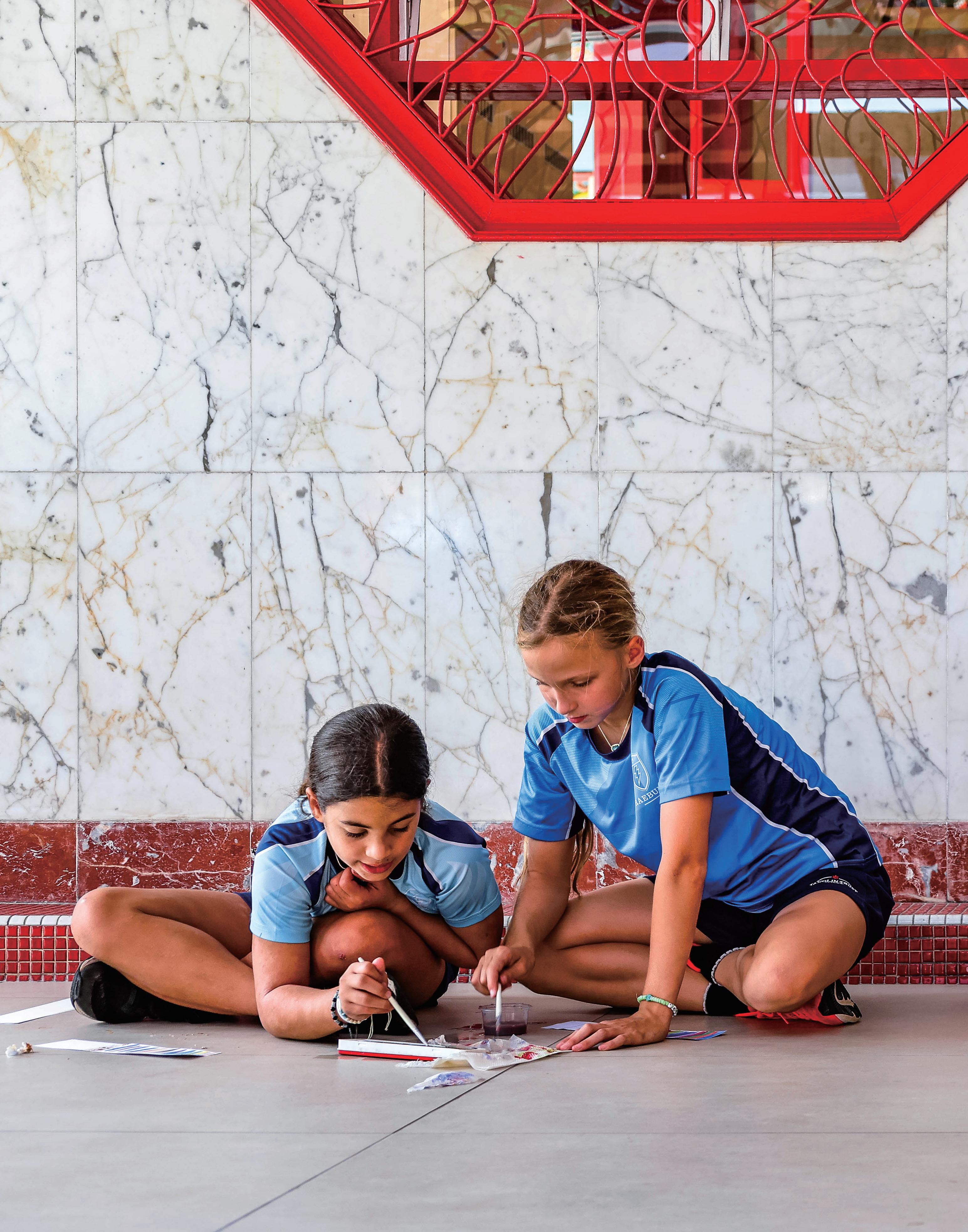





Prioritising your financial goals means you can enjoy what matters to you. As the leading global provider of tax, estates and financial planning advice we’ve been helping clients achieve financial freedom for over 120 years.

Editor
Lilian Wu, Marketing & Communications
Design
Lauren Khoury, Marketing & Communications
Photography
• Marketing & Communications
• Contributors from across the school
“The Voice” herein refers to “The Voice of Tanglin Trust School”
All students’ year groups referenced in this issue are accurate at time of publication.
95 Portsdown Road, Singapore 139299
Tel: 6778 0771
Email: communications@tts.edu.sg
Website: tts.edu.sg


 Tanglin Alumni
Tanglin Alumni
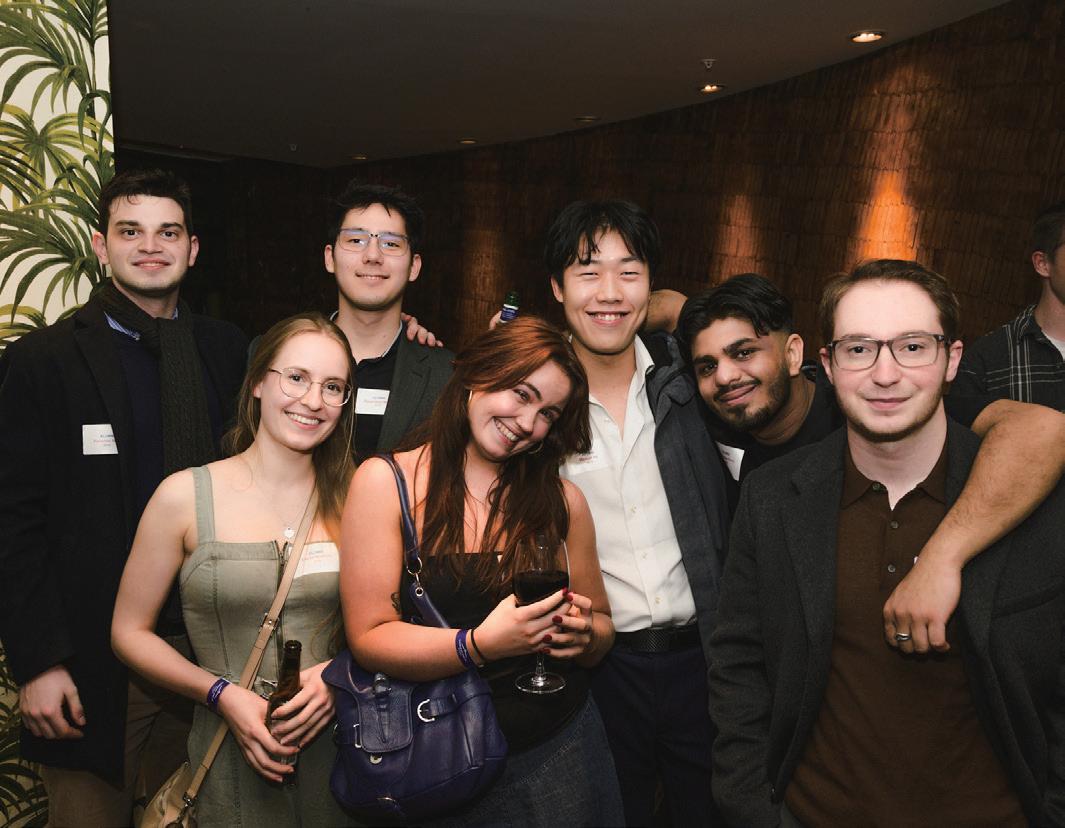
Tanglin provides a remarkably rich ecosystem where innovative ideas can grow. Key phrases in the Tanglin lexicon like ‘inspired learning’, ‘flourishing individuals’, ‘personal best’, and ‘future ready’ reflect our values. These are not sound bites; they are integral aspects of our strategic plan, and they define both current and future characteristics of our community.
In this edition of The Voice, we are delighted to share stories that embody these values and showcase the interesting, purposeful, kind, thoughtful and global-minded ventures our students and alumni are engaged in. Our vibrant community, which includes teachers, former teachers, parents, and other members, lead and drive many opportunities and innovations within and beyond our school in the one-north area. Therefore, it’s good to read about the Centenary Music Scholarships, Tanglin Highlands Programme, athletic development initiatives, and the forthcoming Centenary celebrations.
Beyond school, alumni pathways often reveal the power of unconventional journeys when it comes to driving remarkable achievements. Finding inspiration from those who have walked in similar shoes can be truly transformative. It’s heartening to see Tanglin Alumni sharing valuable insights with current students through our internship programme and special projects funded by the Tanglin Trust School Foundation.
“
It’s heartening to see Tanglin Alumni sharing valuable insights with current students through our internship programme and special projects funded by the Tanglin Trust School Foundation.
This edition of The Voice is brimming with personal narratives, thanks to the wonderful work our Editor, Lilian Wu, Lead Designer, Lauren Khoury, and key contributor Amy Anderson have put in to create this representation of Tanglin life. They are supported by many wonderful writers, photographers and illustrators who have captured the essence of life at Tanglin Trust School in all its glory. Thank you all. I hope you enjoy reading this volume of The Voice
Remember Edmund, our very own ‘Ice King’ (otherwise known as one of Technical Art & Design Executives at Senior School)? He has crafted yet another gorgeous ice room for ICEHOTEL in a collaboration with fellow artist Taitien Tan. Scan the QR code to find out what inspires their design and get swept away by its beauty like we did! Here’s what Edmund has to say about it, “in completing this project, I was enveloped by a wave of emotions that stirred in me a profound sense of wonder, awe, and deeper connection with the natural world. I envision people approaching our work, being captivated by the ephemeral beauty, and contemplating the delicate balance between the forces of creation and destruction that shape our universe. More than anything, I aspire for our art to resonate on a deeper level, touching the depths of people’s souls. I hope our creations ignite a spark of imagination, reminding everyone of the limitless possibilities that lie within their own hearts and minds. In essence, to invoke that childlike wonder, encourage introspection and a shift in artistic perspective. I extend my heartfelt gratitude to Tanglin’s Senior Arts Department, a supportive environment that has been instrumental in my artistic pursuit. Being able to collaborate with and work for ICEHOTEL has been an extraordinary experience that I will forever cherish. Art is not confined to museums or galleries but is omnipresent. I hope that art can continue touching hearts, weaving a tapestry of beauty and reverence in our fleeting world.”

SCAN THE QR CODE TO SEE MORE OF EDMUND’S WORK.
What’s been happening at Tanglin? Keep yourself up to date with these exciting stories!

At the end of Term 1, the school held its inaugural awards assemblies in the Senior School to acknowledge outstanding commitment and achievement across the Co-Curriculum. These assemblies were an opportunity for senior students to gather and celebrate both individual and collective successes across various teams, ensembles, productions, and societies. Instead of simply highlighting individual students, Tanglin now acknowledges exceptional dedication while still appreciating the regular contributions of many through Colours and Awards. These awards not only denote different levels of commitment and accomplishments, they also highlight the behaviour and activity that Tanglin supports. For students in the Middle and Upper Schools, these awards were presented in the form of over 140 achievement certificates in line with the school’s core values: Respect, Responsibility, and Purpose. Sixth Form students, on the other hand, received Colours that represent different levels of commitment and accomplishments that students have achieved across Clubs & Societies, Music, Drama, and Sport categories. Over 110 awards were given out, which highlighted the diverse range of activities students participate in, with some achieving Honours for exceptional success beyond the school

environment. One example is Year 12’s Tamani K, who received honours in recognition of her position on the Singapore National Women’s Open Touch Team. She said, “I am very grateful to have had this opportunity and I hope to inspire younger players within the Tanglin community.”
We hope that these awards will carry significant meaning and inspire students to strive for their personal best.
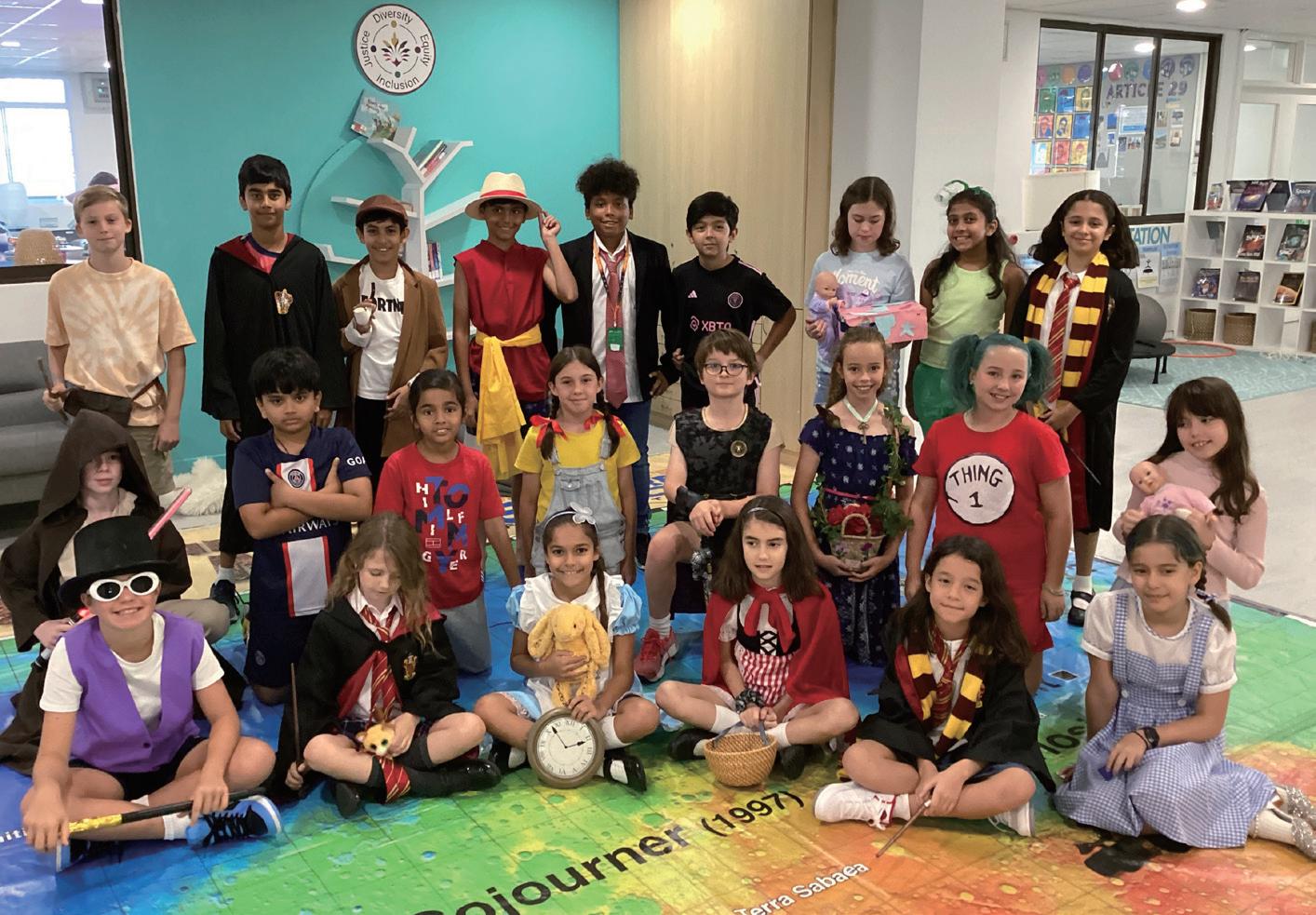

SCAN THE QR CODE TO SEE THE FULL LIST OF STUDENT AWARDEES FOR TERM 1, 2023.
Did you know that Tanglin Trust School was once named in the Guiness World Book of Records for hosting the world’s largest gathering of people dressed as storybook characters on 7 March 2014? It involved 1560 children and staff, and 10 years later, we still hold the record with the certificate proudly displayed in the Junior School Office. This year, Book Week was just as impressive as the school campus transformed into a fantasyland where book characters roamed freely. Wong Swee Yean, a local storyteller, dropped by Nursery and Reception to work her storytelling magic while Junior Buddies got crafty by making a storytelling puppet. Infant children also got to deck out with a ‘Fancy Nancy’ dress-up station in the Infant Library after school on top of a whole host of activities that got everyone’s literary blood pumping with excitement. Such fun!

If you’ve been to the Centenary Building recently, you may have noticed a gorgeous art piece at the end of the hall beside the Gymnasium. Named We Dreamed a Forest, it marks the second installation in the Centennial Arts Trail. This trail showcases unique, original artworks crafted by Singaporean artists, celebrating Tanglin’s rich history, centenary milestone, and enduring connection to Singapore. During her speech at the Tanglin Foundation Members’ Reception to unveil the art piece, Donna reflected on her visit to Tanglin where she noticed the contrasting landscapes around it. She described how she had come across a historical image of a jungle in Germany and realised that it was vastly different from the forests that she had previously explored. She said, “upon further research, I discovered many of the forest images had their roots from 18th and 19th century images of the forest, which were part scientific and part imaginary. The forest I realised was a space that because it was so vast, complex, and so difficult to grasp, became a space that lent itself to the imagination. Artists, scientists, explorers, conquerors all created images of it that suited their agendas or followed existing conventions.

Despite living in the tropics, I realise we seldom question how our forests, have been depicted aesthetically. Traditionally this has veered between an Edenic paradise with endless flora and fauna to discover, or an unruly, dangerous wilderness populated with backward natives. It is important to rethink our forest aesthetics as these affect our thoughts about it and ultimately, how we use and protect it. This work highlights the traditional way of depicting the forest in the upside-down reflected image, with prominent male explorers and forest natives engaged in primitive rituals and tasks. The image that is right side up and easier to view, features some subtle changes to the forest, with the arrangement of trees, and more importantly, changes the figures to lesser depicted inhabitants and visitors to the forest such as Southeast Asian natives, female explorers, nuns and priests, Chinese mine workers, native translators, and guides. By doing so, I hope it provokes thought and dialogue amongst the students and visitors to the school, in thinking more deeply about how the world around us is represented visually and verbally, and how existing conventions affect our thoughts and feelings about those places.”
During the Vietnam War, more than 1,000,000 tons of bombs were dropped in Cambodia. Some of these fail to detonate upon impact, resulting in over 100km2 of land contaminated with landmines and explosive remnants of war. This has led to more than 25,000 amputees - the highest ratio of mine amputees in the world. To address this urgent issue, APOPO, a registered Belgian non-governmental organization and US non-profit, trains southern giant pouched rats to detect landmines in Cambodia. There are currently over 300 trained animals, working to make the country safer and healthier. These animals receive exceptional care, including a balanced diet, regular exercise, personal attention, scheduled playtime, and regular veterinary care. Through these remarkable animals,
APOPO and its partners are making a significant difference in the lives of Cambodians, one step at a time. As part of its ongoing efforts to improve the lives of underprivileged children and their communities, Tanglin has adopted Ronin, a hardworking male rat that specialises in mine detection and loves avocado as a special treat. Jennifer Woods, Assistant Head of Year 5, tells us, “The work that the APOPO rats do in Cambodia is so important and I think it is great news that Tanglin will be sponsoring Ronin. Getting to hold another HeroRAT, also called Jenny, was so exciting when we visited the centre earlier this year. We were even able to see her demonstrate how it is that they detect hidden mines in the countryside of Cambodia. I never thought I would be a rat lover, but these rats really are special.” ■
After graduation, our students continue to be cherished members of the Tanglin community! Here are some recent Alumni from 2023 who returned to their alma mater to experience what it’s like to work in an international school.
Eve MaguireI came to Tanglin in Year 10 after moving from Scotland to Singapore. I completed my GCSEs before returning to school in Glasgow, where I’m from, for one final year and heading to Glasgow University in 2020 to study English Literature and Theatre. I jumped at the opportunity to return to Tanglin and do my internship in the Senior Drama Department. It was an amazing way to fill my time off from university, whilst also further developing my skills in my chosen subject and getting to travel somewhere away from home to do so! When I was new to Tanglin, the drama department was my safe space and the subject I looked forward to most when I was feeling stressed or out of place as a new student. I grew hugely as a student and performer through the GCSE drama process and being in the Senior drama department here completely changed my plans for university and put me on the path to study Theatre in further education.
I was lucky to be doing my internship at the same time as West End professionals James and Noel who were scheduled to visit Tanglin for five weeks. Being able to take part in their workshops and seeing how they carried themselves as performers and teachers in their field was as beneficial to me as it was to the students! Over the course of my internship, I worked with every teacher in the drama department and observed how their teaching styles and methods of creative pieces and ensembles varied. This gave me a lot of new ideas and showed me what a potential career as a teacher or instructor within a theatre environment could look like, whilst further helping me shape my idea of the type of creative I want to be and the work I want to do.
After I finish my degree next year, my plan is to move to London to pursue theatre work and writing. My current goal is to land a place in the REP Company with National Youth Theatre or secure a writing internship, but I remain open-minded and am excited to see where the adventure takes me!

I grew hugely as a student and performer through the GCSE drama process and being in the Senior drama department here completely changed my plans for university and put me on the path to study Theatre in further education.

I’m half Italian and half English, but I was born in Singapore. I attended Tanglin from Nursery to Year 8 before relocating to the Netherlands where I completed my GCSEs and A-Levels. I’m currently pursuing a BA in Primary Education (QTS) at the University of Roehampton in London. When I received the internship email, I recognised it as an incredible opportunity to gain valuable experience in my field of work and to return to my birthplace after being away for over five years. I was thrilled to be selected for the Junior Art internship role, as it aligns perfectly with my course specialisation in Art and Design and my focus on the KS1/2 pathway. I found it rewarding to work with both Year 3 and 6 students, as it allowed me to explore a variety of specialised lessons and teaching approaches. I also had the opportunity to assist Year 4 and 5 students during their art sessions in class, which gave me insights into classroom activities and the challenges that teachers may encounter. Witnessing the students’ progress, especially in
‘‘ I engaged in productive discussions with my line manager, receiving constructive feedback that allowed me to identify both my strengths and areas in need of improvement.
Year 3, as they honed their artistic skills and experienced personal growth while finding a sense of belonging in Junior School was a highlight for me. The internship provided me with a platform to practise the skills I acquired during my first year at Roehampton. I engaged in productive discussions with my line manager, receiving constructive feedback that allowed me to identify both my strengths and areas in need of improvement. The lessons in technical skills I received from the delightful art technician were also helpful. Overall, this internship has been immensely beneficial for my future career, as it closely aligns with the subject matter and age group that are highly relevant to my university course. My aspiration is to successfully complete my studies at the University of Roehampton and fulfil my early career teacher (ECT) years in England. Subsequently, I aim to pursue a career in international schools abroad such as The British School in The Netherlands and Tanglin.
»

I joined Tanglin in Year 2 and graduated Year 13 in 2020. I then went on to attend the University of Warwick to study Psychology with Linguistics. When I saw the LinkedIn advertisement for the internship, it was clear that the opportunity would allow me to develop new experiences and skills as well as gain a better understanding of what I’d look for in a job. I also remembered how much my older brother enjoyed it as an alumnus, so I decided to sign up. Upon acceptance, it was decided that I’d be best suited for Senior School’s Psychology department due to my university course. I had also studied GCSE Psychology when I was at Tanglin, so this was the perfect placement for me. I taught some classes under supervision, ran sessions at the Psychology Society and developed class materials. While I had tutored in the past, I was unfamiliar with classroom teaching. But it was an exciting challenge as I enjoyed learning how to engage the students, adapt my teaching methods according to student demographic and think on my feet when things didn’t go according to plan. Another highlight sharing my own experiences on revision techniques because I felt that it would give students a different perspective and encourage them to reach their full potential. This helped me realise how impactful it is to be in a leadership or teaching position and may be something I will consider in a career. I found the internship immensely useful because it taught me a lot, but I had to be open to learning and actively participating. I jumped at any opportunity to further my experiences. When I finished my tasks, I’d look for more things to do. When things slowed down in my department, I took the initiative to offer my help in other departments like assisting in Biology, Philosophy and EPQ classes. I also got a valuable insight into the complex balance between employees and the organisation, which helped me understand the importance of social psychology when running a company and piquing my interest in organisational psychology.

I moved to Singapore from Paris and joined the French School when I was 3 years old. I then decided to join Tanglin in Year 10 as I felt more confident learning in English and the subjects offered were very interesting to me. I obtained my IGCSE and A-Levels at Tanglin and graduated in the Class of 2023. After graduating, I received my enlistment date for National Service. It’d start in October, so this meant that I had time to explore different careers through internships. It’s important to me as I still wasn’t sure what I’d like to do in future. I learned about the internship programme and decided to sign up for a teaching assistant role in Year 1 and 2. It was an attractive opportunity because I had always considered a career in Infant education. I was already familiar with the environment and knew I would be supported by my colleagues. Furthermore, the roles offered were hands on and I was keen to get involved. While I was a student, I worked as a babysitter and volunteered for Girl Guiding where I assisted the scout leaders and scouts with daily activities and challenges. Being able to help children develop skills and see them have fun was extremely rewarding, so it piqued my interest in Infant education. During my internship, I learned so much from the children as I spent time helping them with Maths, English or just playing games on the field during their break and lunch. Seeing them flourish and get more confident was truly rewarding. Little things like children saying ‘Have a good weekend, Mr Arthur’ or being given a card on Teachers’ Day was very heartwarming and motivated me to do my absolute best. I learned a lot about the school’s Curiosity Approach, thanks to my supportive colleagues – many of whom became my friends! I also enjoyed the fact I was able to do independent activities and suggest ideas. These factors allowed me to experience what it would be like to work in Infant education, and it has given me a thorough look into what it would be like. ■
The art scene at Tanglin remains vibrant, and our students’ creative endeavours are flourishing. Let’s take a look at what they’ve
Growing up in Southeast Asia, Tanglin children are privileged to be immersed in a diverse and enriching environment that provides abundant opportunities for learning. Our young learners possess innate curiosity and keen observation skills, transforming the world around them into a canvas for exploration and creative expression. Whether the setting is natural or man-made, this environment becomes a playground for nurturing imagination, refining fine motor skills, and cultivating a profound understanding of the world.
Nature, with its vibrant colours, diverse shapes, and varied textures, acts as an infinite wellspring of inspiration for early years art. Outdoor spaces offer a plethora of learning prospects as children interact with the elements. Nature walks transcend mere exploration; they become sensory experiences where children investigate how leaves, pebbles, and flowers can elevate their artistic creations. This not only enhances their appreciation of the natural world but also sparks scientific inquiry as they observe and question the characteristics of the items they discover.
Engaging in art outdoors goes beyond creative expression; it contributes significantly to physical development. Whether it’s painting on easels, moulding clay, or using chalk on pavements, children participate in activities that refine their fine motor skills and hand-eye coordination. These kinaesthetic experiences are instrumental in developing both gross and fine motor control, forming essential foundations for later academic and life skills.
been working on the past few months.
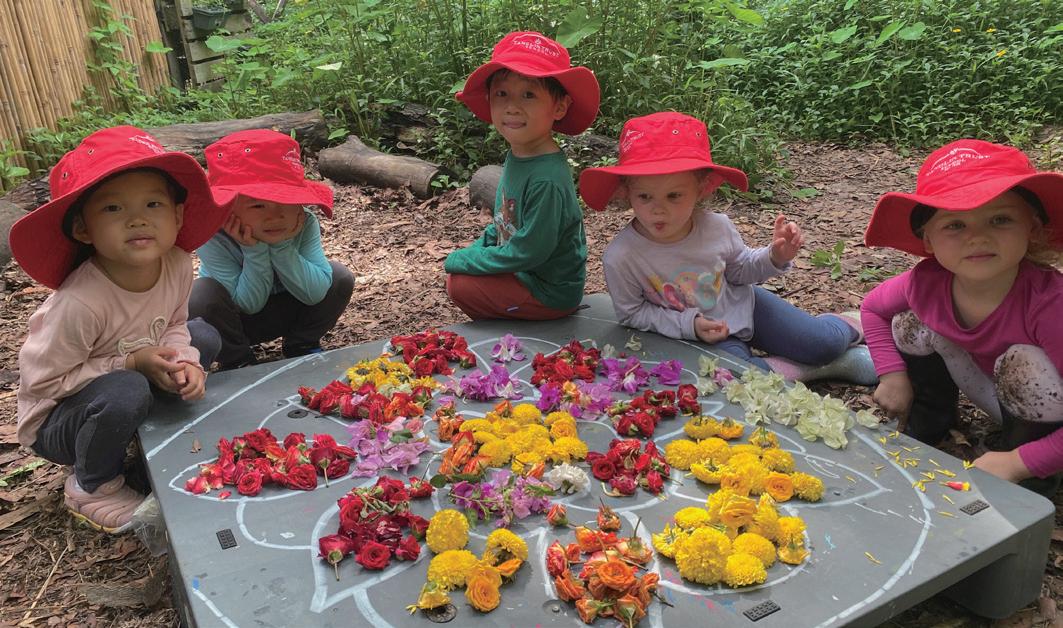
and execute their artistic visions.
The built environment of Singapore provides yet another distinctive backdrop for early years art. The city’s skyline and architecture become canvases for exploration, offering children opportunities to delve into shapes, patterns, and spatial relationships. Drawing or constructing models of buildings such as Marina Bay Sands, not only engages their artistic sensibilities but also lays the groundwork for mathematical concepts such as geometry and symmetry. The built environment serves as a tangible and relatable context for learning, seamlessly bridging the gap between art and other academic disciplines.
Collaborative art is huge part of what we do. These projects, whether outdoors or indoors, act as platforms for social and emotional development. Children learn the art of sharing ideas, negotiation, and collective effort toward a common goal. This fosters a sense of belonging and cooperation, nurturing the interpersonal skills crucial for their future interactions.
At Tanglin, teachers seize every opportunity to integrate art with other areas of learning. This not only ensures comprehensive curriculum coverage but also enables children to gain a deeper understanding of concepts, facilitating the creation of meaningful links between different areas of learning. Whether utilising digital art tools to create in the style of Kusama, applying knowledge of shapes to interpret a Kandinsky painting, or exploring the wonders of plants through creations inspired by Andy Goldsworthy, Tanglin children are encouraged to see the magic of art in their surroundings every day.
One avenue through which we maximise the learning potential of our environment is our Forest School programme. In this lush area, equipped with diverse materials like paint, brushes, natural objects, and recycled materials, children have the opportunity to experiment with various mediums. Both structured and unstructured art activities in these spaces foster problem-solving, critical thinking, and decision-making as our young learners plan »

This term in Art, as part of a cross curricular focus on the beautiful and diverse wildlife of Singapore, the Year 4 students are exploring techniques of sketching and painting to create their own painting compositions of a chosen Singapore bird, or to choose to create a bird composition of their own creative imagination inspired by images of Singapore birds.
A key element of this project was for the children to practically experience the techniques of sketching; to progressively develop their skills in sketching, widen their understanding of the differences between sketching and drawing, and to recognise the importance of sketching in their own art and the work of other artists.
Through a series of observational sketching activities inspired by looking at images and videos of birds, observation of feathers, examination of close-up images of different types of birds, and teacher modelled examples, the Year 4 children developed their understanding of several techniques. This includes the use of guidelines for proportion and positioning as a scaffolding in their drawing, using comparative visual measurement (visually comparing proportions and sizes of shapes to one another without using a ruler), breaking down complex shapes into simpler forms, and using lots of loose, flowing lines as they construct their sketches of Singapore birds.
One of the fundamental pillars of art and drawing lies in the
mastery and application of the precise techniques of sketching. A key element of this project was for the children to practise the techniques of sketching and more importantly recognise the huge value of sketching in all aspects of drawing, design, and painting.
Sketching provides an exciting conduit for children to develop their observation skills and to develop self-confidence to draw and paint more complex forms. It fosters their ‘artist’s eye’, focusing on looking at complex forms and deconstructing them into observable simple shapes that can be successfully drawn. The complex becomes more accessible to draw, through the use of scaffolding (guidelines and comparative measurements) deconstruction and avoiding focusing on details.
The children’s sketching consists of light pencil strokes; shapes being created through a series of loose lines that can easily be erased. This actively promotes a greater self-confidence and risk taking in children’s drawing of objects and images they observe, as it moves away from the tendency to try and draw accurately, which can negatively propagate the feeling of trying to get it right first time.
Sketching fosters children’s confidence, encourages exploration and experimentation, and promotes the development of fine motor skills and observational awareness. It enables children to visually connect with what they observe by simplifying complex forms into basic shapes, deconstructing intricate objects, and avoiding
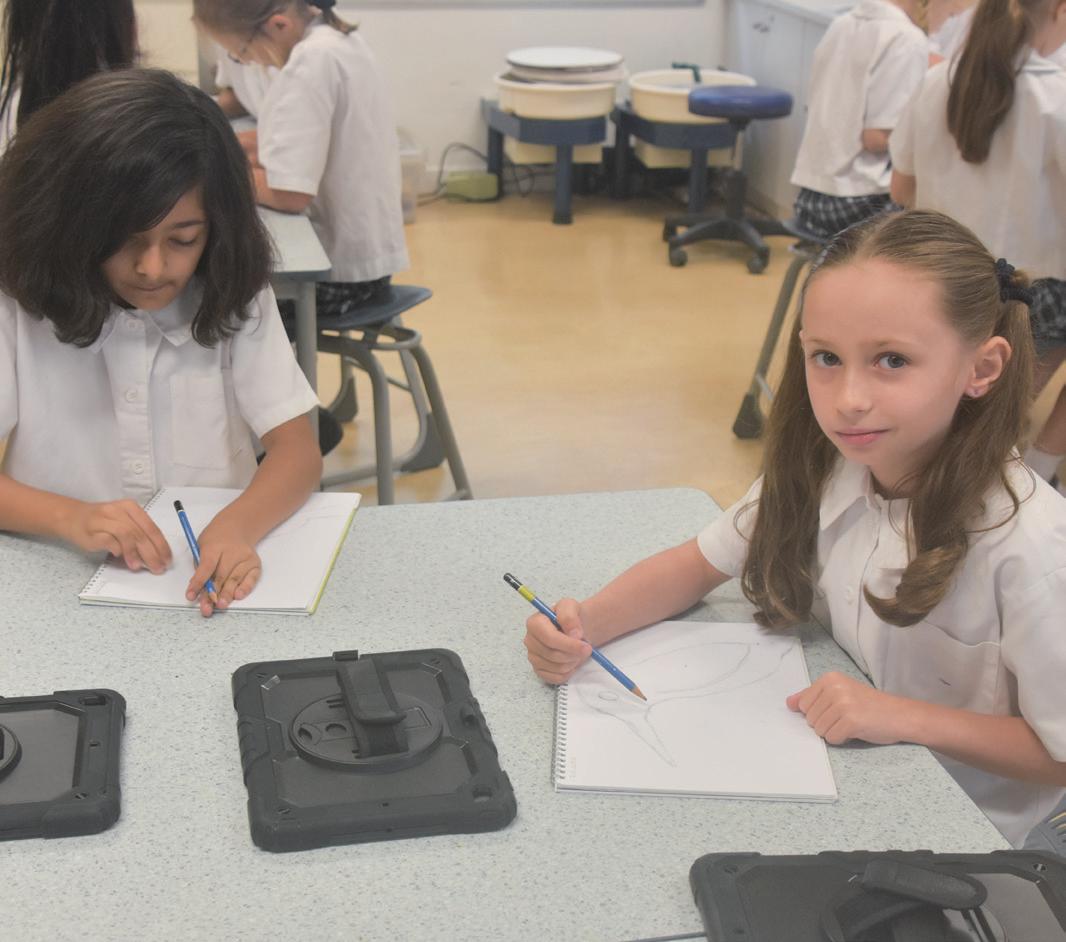

distractions from excessive details. Sketching is also a form of visual and kinetic problem solving, much like constructing a LEGO model. The Year 4 students observed an object and through the sketching, processed the problem, and solved it by analysing how to ‘build’ it through connecting shapes and lines.
The loose physical movement of sketching pencil lines also helps the children to relax as the observed form takes shape on the paper through a series of flowing lines, and with the addition of relaxing music in the background, the experience becomes a relaxing activity.
After successfully sketching Singapore birds, Year 4 students are now utilising their sketches to craft vibrant painting compositions, a project they aim to complete this term. The true test of mastering a newly taught skill or technique lies in its independent application to other design projects. As our Year 4 students progressively develop their sketching techniques, they are also recognising its important role in the design and drawing process for their painting project. The next stage will involve applying these skills to new art projects, including observational sketching ‘in the field’ of observed objects. In Term 3, the students will explore a wider range of media and techniques. A keystone for these future projects will be their foundational understanding of sketching techniques and how they can be applied independently and confidently to their design. »

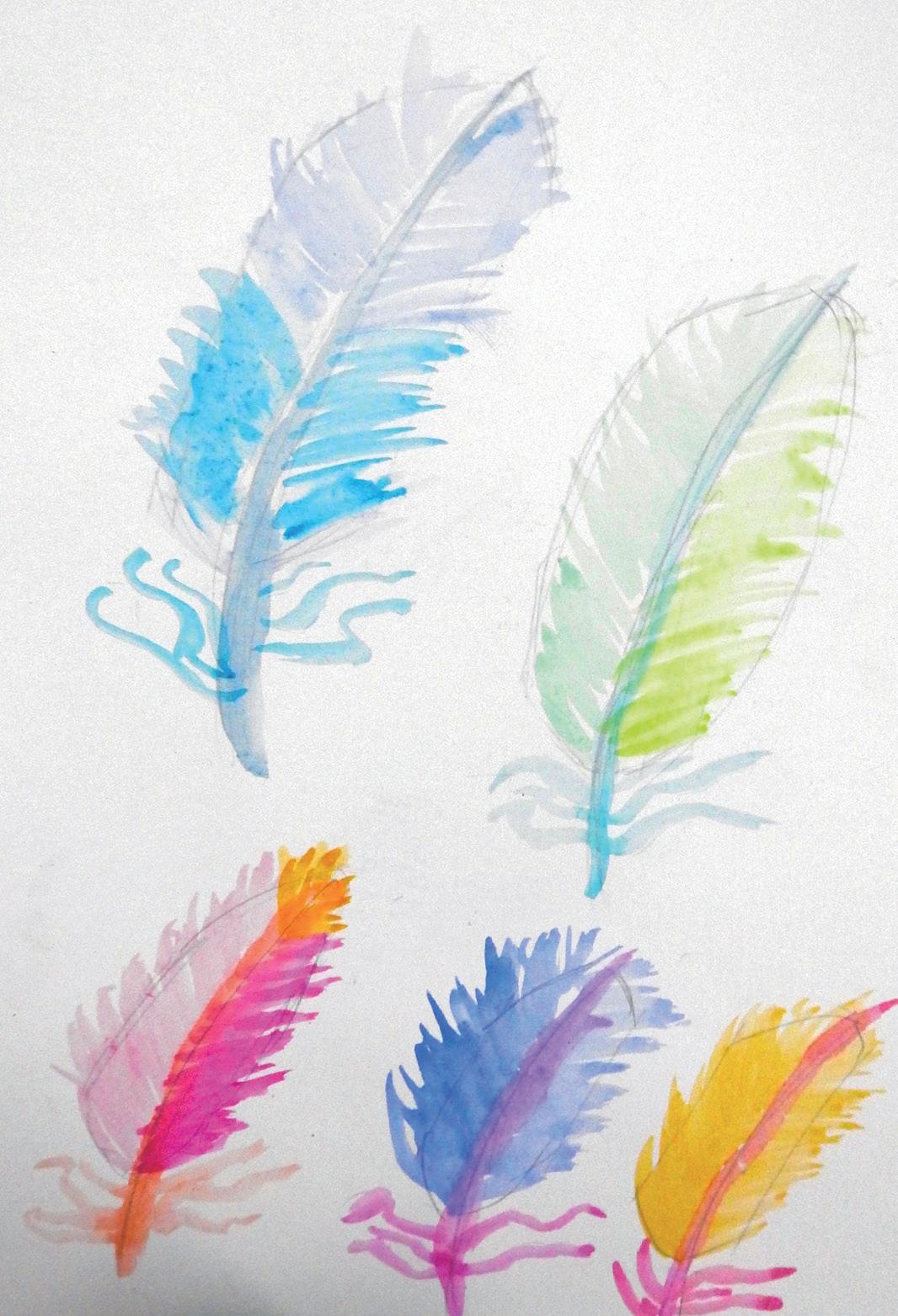
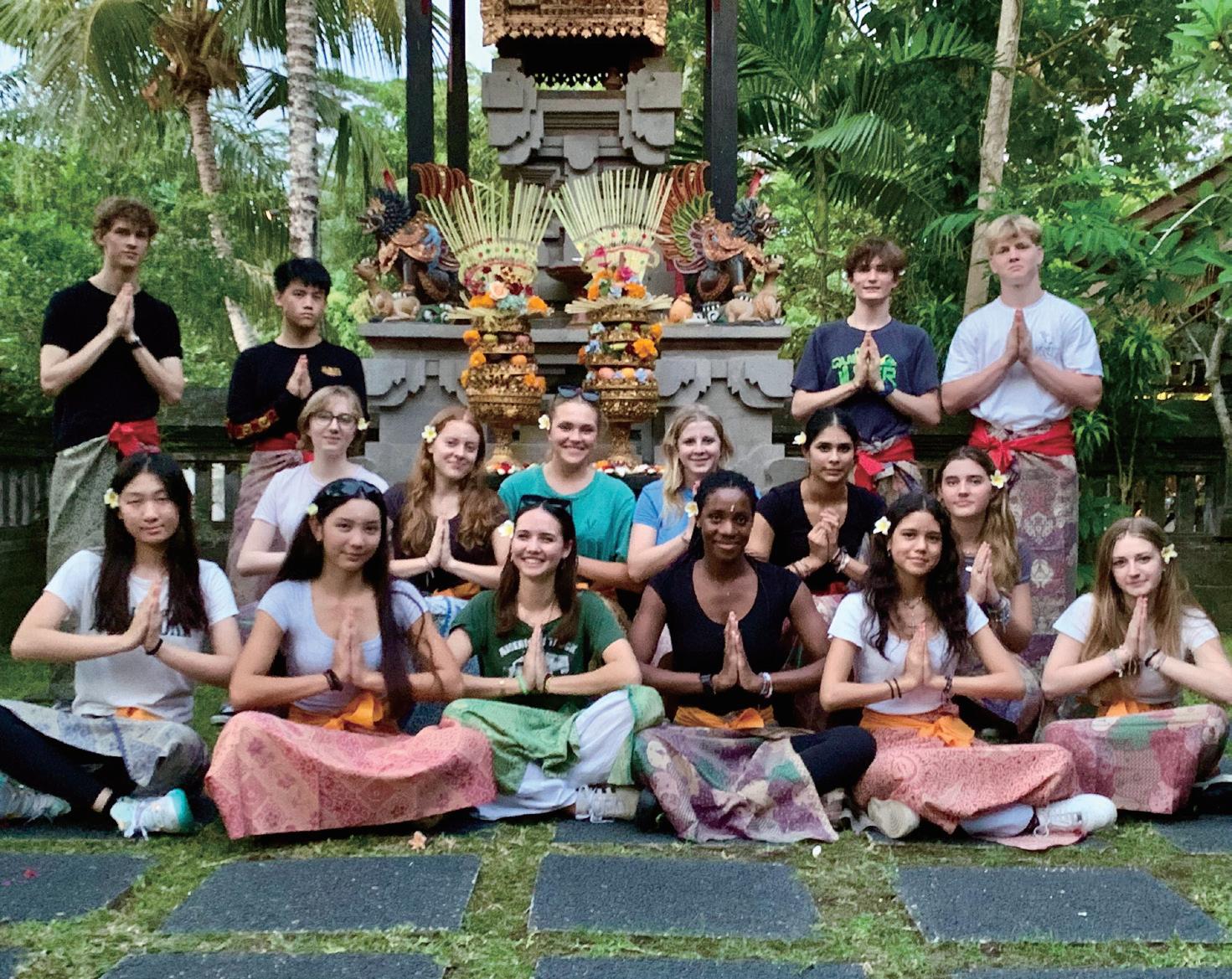

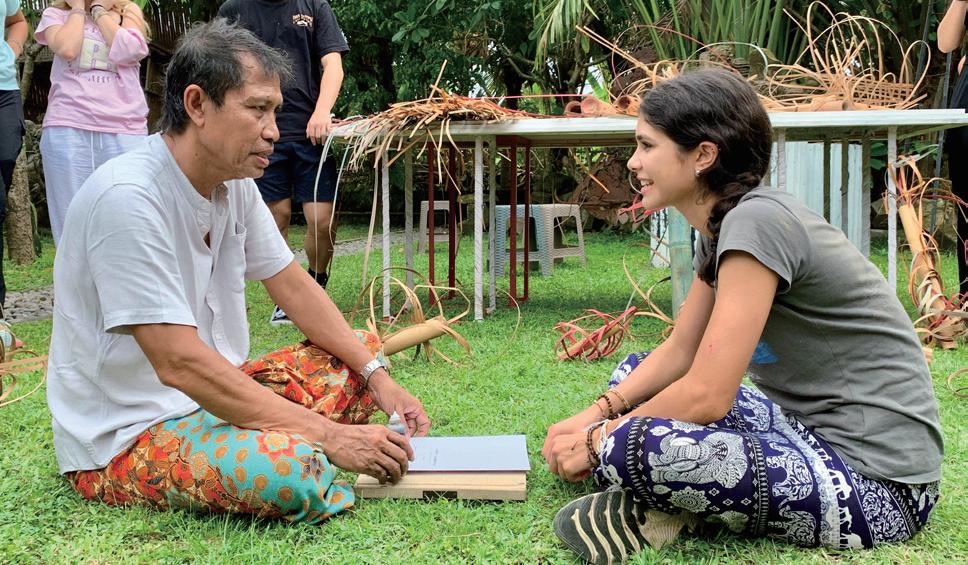
In January 2024, the Senior Art Department was delighted to begin the year with an amazing cultural trip for our Year 12 Art Students. Designed to provide an exciting stimulus and springboard for coursework and also to help build a collaborative ethos amongst students and staff, we headed to Ubud for four activity packed days. A major centre of the Balinese culture and local spirituality, the city has attracted artists and travellers for nearly a century and is the perfect location to visit temples, see Balinese art, observe cultural performances, practice yoga, and pursue a healthy lifestyle. We worked closely with trip provider Odyssey Institute to flesh out a busy programme that would challenge our students and provide lots of opportunities to be inspired and creative. Armed with custom made concertina sketchbooks, a challenge was made for all to record a rich visual narrative of their journey.
Our adventure started with a swift visit to the ARMA gallery, housing both traditional and contemporary collections focused on Bali inspired art, students photographed and sketched their favourite works. On returning to our cosy hotel set within lush surroundings, we were greeted by a local lady who gave us an interesting insight into the importance of making daily offerings within the local culture. After teaching the students how to
build canangs (while wearing sarongs out of respect), students were invited to make offerings in a local temple, while taking a moment to reflect on what they were grateful for in their lives or at that moment. This was a calming way to complete our first day.
An introduction to traditional batik was delivered Friday morning, with students reflecting on their gallery research to create appropriate motifs with hot wax onto a fabric scarf, brushing on paraffin wax to create a crackled textured surface. The transforming moment was dunking their patterned cloth into natural dyes to fix colour and then submerging the fabric into boiling water to remove the wax, finally revealing the finished textile. A delicious traditional meal followed, providing energy for the next activity. The Setia Darma House of Masks & Puppets houses a collection of over 500 artefacts gathered from around Southeast Asia. Students discovered works of personal interest and recorded them directly from life in their sketchbooks.
A trip to Mepantigan followed, with most being pushed out of their comfort zones, learning Balinese self-defence routines on land before progressing to tussling with the instructors within wet & muddy rice paddy fields – a spectacular location full of laughter and physical exertion. A hot shower back at the hotel


was very welcome and revived all enough to finish the day with some twilight sketchbook work before a well earning night’s sleep.
Saturday morning was spent with an ‘Old friend of Tanglin’, Pak Suklu Rumah, a local artist and University lecturer who provided us with two contrasting art experiences. Novel drawings required all to make expressive charcoal marks directly onto the typed pages of recycled books requiring individuals to take a more spiritual approach to mark-making, considering expression rather than tight representation. Building Sculptures in cane followed, exploring the qualities of the material - strength verses flexibility in order to build a 3D form from natural local materials. The workshop concluding with a ceremony with Suklu engaging directly with each student as he spoke to them and then created an individualised ink drawing for each to treasure.
After a delicious lunch, we travelled to Sanggar Paripurna to meet Pak Made Sidia, a world renowned shadow puppet performer. After watching a traditional shadow puppet performance, students divided into teams to design their own puppets and to build a scripted continuum of the story. Each group then had to coordinate the delivery of their original tale with narration along with convincing puppet movement behind

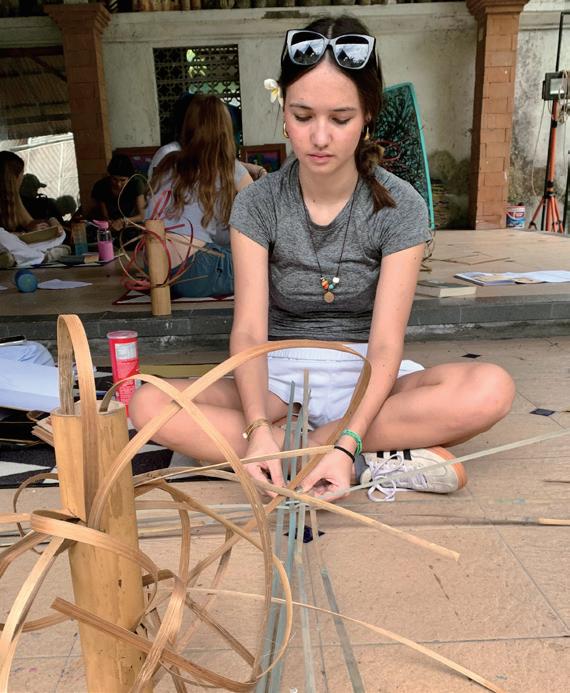


the projection screen, while Gamelan musicians carefully watched the action and provided an appropriate soundtrack. Some hilarious sequences were performed and were greatly appreciated by the audience. Some well-deserved chill out time at the hotel pool brought another busy day to a close.
The final day provided a more relaxing schedule with time after breakfast to find an inspiring space to create large scale observational drawings and paintings upon paper prepared with subtle colour stain prior to the trip. We then transited to Tita Empul for a water temple ceremony dressed in traditional costume where we made offerings and grabbed our last photos, as well as bartered for some bargain souvenirs from the craft market before heading off to Ngurah Rai International Airport.
It was such a fabulous opportunity to have a large block of time for our students to immerse themselves purely within art and culture and we are truly excited to see what the students are able to produce for coursework as evidence of this unforgettable trip. Hopefully we can share this work with our community in the form of an exhibition later in the year.
Thank you so much to the Year 12 Art Students, Odyssey Institute and to Ms Clancy for helping to make the trip such a success! ■

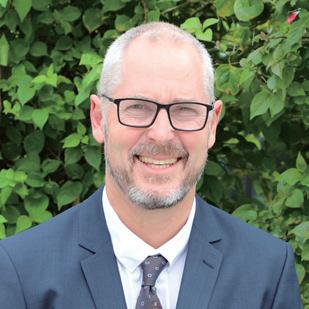
Experiential learning has long been recognised as one of the most effective educational approaches.
Now, Tanglin is taking it a step further with the Tanglin Highlands Programme, led by Mark Cutchie, its inaugural Head of Campus. Read on to find out more.

The Tanglin Highlands Programme is a five-week immersive learning journey at its Tanglin Gippsland campus in Australia and is the pinnacle of a Year 9’s Middle School education at Tanglin. Since Year 9 will be a formative year for adolescent development, the programme will focus on fostering three essential attributes: curiosity, confidence, and community. Students will also:
• Boost their self-esteem and confidence.
• Gain greater independence by learning to make their own decisions and taking responsibility.
• Enhance their resilience.
• Improve their social and teamwork abilities.
• Acquire new skills and fresh inspiration.
• Strengthen their leadership qualities.
• Form lasting friendships.
• Expand their comfort zones through challenging but fun activities.
• Gain an unforgettable experience that will leave a lasting impact.
The programme goes beyond preparing students for the present; it’s a commitment to invest in both their future and the growth of generations to come. We want to ensure that they have the skills and mindset to succeed in a changing world. It’s our way of providing a holistic education that goes
The programme goes beyond preparing students for the present; it’s a commitment to invest in both their future and the growth of generations to come

beyond books and classrooms as we continue to nurture lifelong learners who can contribute with confidence to our world. Students won’t just learn academic subjects such as English, Mathematics, Geography and Science (with a focus on Biology) that are in line with the Tanglin 3-14 curriculum. They will participate in Outdoor Education Studies, Positive Education, and fitness programmes designed to enhance their overall fitness, strength, and endurance – all of which will culminate in a transformative Rite of Passage. The curriculum also integrates experiential learning through academic field trips, ecological studies, community interaction, and service learning. Overall, the programme is a holistic way for Year 9 students to learn and grow.

Want to find out more about the programme?
Then scan the QR code to read the brochure.
Now that we are familiar with the Tanglin Highlands Programme, who will be leading this initiative? We sat down with Mark Cutchie, the Head of Campus, to learn more.
Tell us a little about yourself.
I was a physical education teacher in outdoor learning and agriculture for four or five years before I decided I was ready for something different. Influenced by a couple of friends who were already paramedics, I decided to join the ambulance service. My role was multifaceted, involving not only typical on-road responses but also various responsibilities. I have extensive experience working with schools on governance issues and sat on school boards at local and national levels, engaged in professional development, teaching

paramedicine, assumed management roles, and contributed to emergency responses during events such bushfires and floods in remote areas and the wilderness.
What inspired you to apply for the Head of Campus role?
To tell the truth, the job found me instead. I wasn’t exactly looking for a job, but I’d started to have conversations with my wife about how I might have reached the limit of what I wanted to achieve in the ambulance service. I’ve had a great career and still enjoyed the job, but I felt like I had done everything I wanted to do and was wondering if there was something else that I could do. Around that time, my brother, who is a teacher and in a leadership position, came across the Tanglin job advertisement. Knowing my passion for outdoor adventures and camping, he forwarded it to me, suggesting I take a look. Initially, I found it interesting but didn’t consider it a viable option for myself because I wasn’t exactly looking to go back into education. My brother then called the recruitment agency on my behalf, telling them they needed to speak with me. Soon after, I received a call
from their recruiter who wanted to discuss my background. The recruiter was particularly interested in my emergency management experience and school governance work so they suggested that I might be a good fit for the role and asked if I’d consider it. I was grateful that they’d reached out to me, so I decided to take another look and the rest is history.
What makes Australia such a suitable location for the Highlands Programme?
There are several reasons. Australia is significantly different from Singapore, and it provides an immersive natural environment that Singapore’s urban setting cannot match. Australia’s diverse ecosystems not only provide unique opportunities for students to learn and explore; its distinct climate also gives a varied and enriching outdoor experience.
How would you define a successful residential programme?
Just being in the Australian bush is a unique challenge

and I hope that students will embrace it with enthusiasm. For those new to this experience, simply attempting it is a significant achievement to me. For others, it’ll be an opportunity for them to push their boundaries and test their physical and mental limits. I believe that these challenges can help students develop resilience, grit, perseverance, and expand their understanding of what they are capable of.
Our approach is to have a sliding scale for activities and recognising that just trying something new can be a significant challenge for some students. Activities can be modified to accommodate different abilities, not just physically, but also confidence levels. For example, we will provide structured support for those who may find certain tasks challenging, while those who find them easy will be given more advanced ones. It’s important to remember that if we push too hard, we risk losing the opportunity for students to learn. We don’t want to make things so difficult
that they become unenjoyable or impossible to achieve, as that would defeat the purpose of the programme. We’ll support and encourage all students, ensuring that the experience is enriching for everyone.
My vision is for the Highlands Programme to be fully integrated as part of Tanglin, rather than seen as a separate entity. It’s important to me that it’s not just an outdoor adventure camp, but an extension of the Tanglin curriculum, where students learn in a different way. The programme will offer a variety of outdoor activities, but the focus is on experiential learning, not just outdoor education. It’s also vital that what students learn in Australia is relevant to their education in Singapore, and vice versa. ■
A big thank you to Mark for sharing his story and vision for the Tanglin Highlands Programme. More information on the programme will be available in the upcoming weeks, so stay tuned to the parent newsletter for more information!

If you frequently attend parent events at Tanglin, you might have met the Development Team: Abhra Bhattacharjee, Development Director & Head of Tanglin Trust School Foundation, and Nasha Pestonji, Philanthropy Manager. While they fulfil a crucial role, who are they behind the titles? Read on to find out more about these key members of our community.
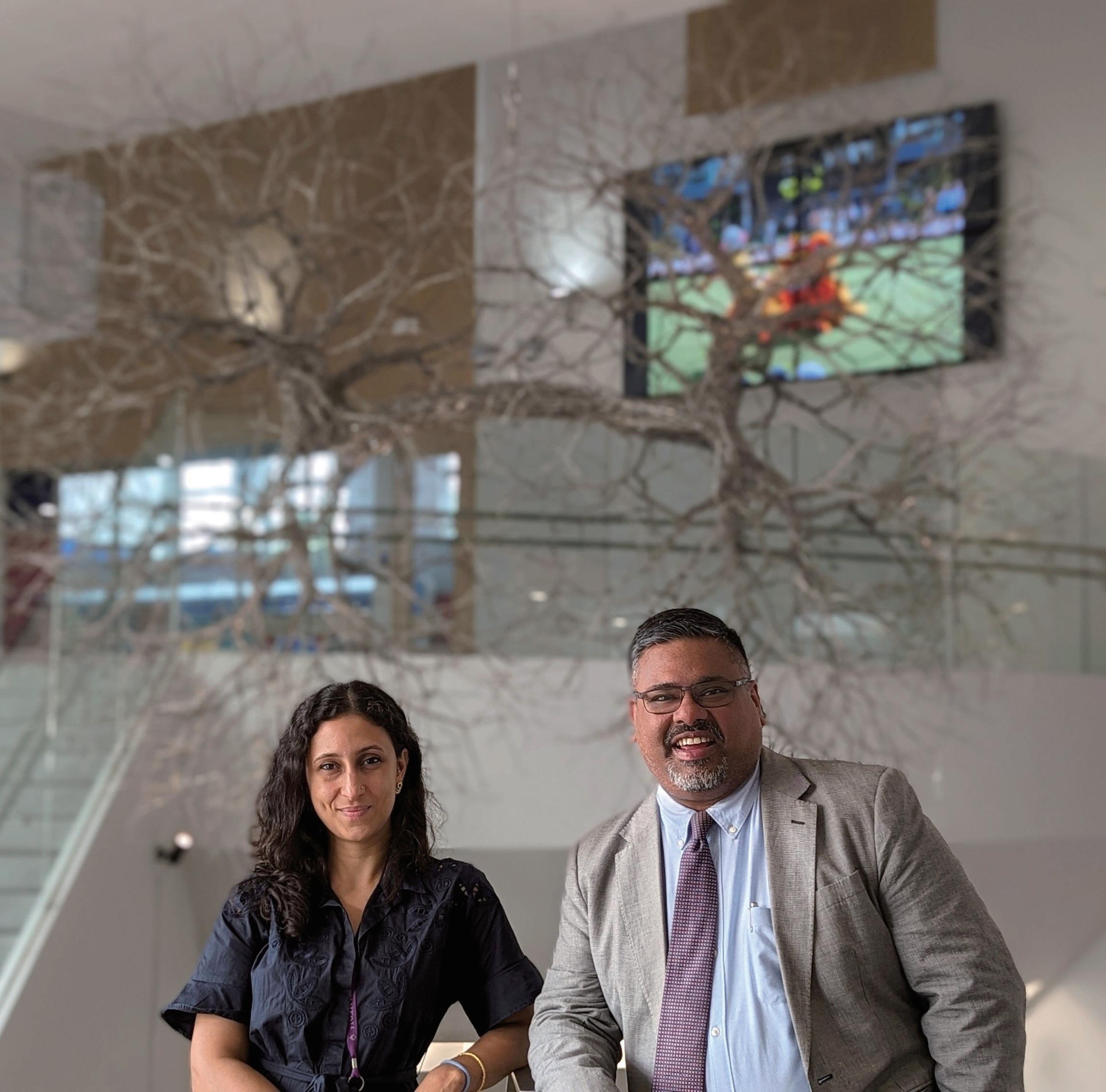

Abhra: I came to Tanglin in November 2022, after ten years at Scotch College Adelaide in South Australia. Before that we lived and worked at Woodstock School in India, and prior to that, we lived in Singapore for four years. I was born in India and have also spent some of my childhood in Kenya. In my professional career, I have led successful capital campaigns for two of Asia’s leading independent schools, built and motivated teams to exceed expectations and helped establish sustainable cultures of philanthropy amongst complex and diverse stakeholders. I have led geographically dispersed teams for multinationals and worked for enduring institutions with proud histories and helped them to do more. As my family and I return to Singapore after more than a decade away, I am excited by the opportunity to make an even greater impact at one of the world’s leading schools.
Nasha: It has been 10 years since I moved to Singapore from Australia and it’s been quite the journey getting married, raising two children, and travelling within Southeast Asia. I was born and raised in Lahore, Pakistan, till my teens. I grew up amongst a close-knit Zoroastrian community that has its roots originating back to Iran. We migrated to Australia as a family when I was in high school, and I am lucky to have called Sydney home for many years surrounded with natural beauty, and a healthy dose of wildlife. While completing my Social Sciences degree in Sydney (Macquarie University), there was a constant itch to explore landscapes and people from around the world. I didn’t quite make it to Machu Picchu, which was my first choice in my university’s
volunteer programme, but I did make it to the Philippines where I spent two months working with a child’s rights organisationmaking this one of the highlights of my life. I met and worked with some of the most resilient and cheerful people there, and ventured to some of the most beautiful volcanoes, rice paddies, and beaches where you won’t see a soul for miles.
As a professional, I yearned to be of service and had an immense passion for community work. In my early years in Singapore, I was involved with start-ups and international organisations that strived to improve housing, sanitation, and uplift those in poverty. These were tremendous years, where I was exposed to many parts of Southeast Asia and Singapore which were often underserved. I also supported low-income families in their asset building journey, and this was by far the most rewarding and challenging role for me, as I navigated the public system intersecting with personal aspirations of young families. Since joining Tanglin in July 2023, I have been surrounded with sheer positivity. The community here is special and I am so glad to be part of an institution where education and purpose come together.
Abhra: A lot of my role is about being a catalyst - an agent that accelerates change in culture. It is about aligning Tanglin’s case for support (why people give), with the philanthropic capacity

in the community (how they give). If we can do that over and over again, we will change the culture!
Nasha: As the Philanthropy Manager, I’m part of a small team that grows “Giving” at Tanglin. “Giving” at an educational institute like Tanglin has many benefits, but the main benefit is to enable our students to access a range of experiences that are above and beyond their daily curriculum. I interact with our generous donors (most of them from our parent community) but the most energising part of my role is working with our passionate Foundation Advocates (volunteers). A few pioneers have been flying the Foundation flag for many years. I also steward our philanthropic community in various ways so they can understand how their donations are used and bring together the philanthropic community to connect with one another. More recently, I spent a few mornings talking to new parents at the school, and hearing about their journey that brought them to Tanglin.
Abhra: A special moment for me was when Craig and I unveiled the Foundation Honour Board at the beginning of the 2023-24 academic year. It is a celebration of Tanglin’s philanthropic culture and the many families who have made Tanglin a philanthropic priority, and the first time that the school honoured them in
this way. I am also really proud of the work done by the team to transform regular giving at Tanglin - we have set new records in the last two years and helped engage our generous community.
Nasha: I had just finished meeting with a new parent and when I reached my desk, we had already received a generous contribution from them to the Foundation. It showed me that parents really cared and were willing to go above and beyond, not just for their child but for the wider Tanglin community.
Abhra: Humility: This is the foundation of realising that no one knows it all and each solicitation is a genuine learning opportunity. Good fundraisers need to keep their egos in check. Enthusiasm for every ask: I fundamentally believe that reward comes with risk and if you don’t ask, you don’t get. The capacity to ask is like exercising a muscle. Do it regularly and well, and the muscle grows, don’t do it often, and the muscle atrophies. Oral and written communication skills and active listening: Many people mistakenly assume that we can talk people into making a gift. The opposite is true - in most successful solicitations, the donor talks 75% of the time, while development person talks the other 25%. But they know how to make every second of their 25% count. When we guide the discussion and


ask the right questions; we are usually successful.
A broad set of interests: This allows me to relate more effectively to donors, no matter their age and walk of life. It also helps to read regularly and keep up with the news, which allows us to have great conversations and connect with others.
Chutzpah: Chutzpah does not always translate well into English, but it implies the admirable characteristics of courage, guts, and the belief that more is possible. It’s diplomatically asking and reminding influential people to take action and dream big dreams.
Nasha: Although this role is formally about fundraising, communications, and record keeping, it’s much more than that. I would say a Philanthropy Manager is more of a relationship manager across the school and a community builder. We are at a stage where Philanthropy at Tanglin is growing and thinking on our feet is needed as part of the process so we can explore and try new things.
Abhra: My hope is that I can be part of the effort to embed a culture of philanthropy at Tanglin. That means changing what people think and say, what they know and what they do. They say that “culture eats strategy for breakfast” and I know that changing culture takes time.
“ I had just finished meeting with a new parent and when I reached my desk, we had already received a generous contribution from them to the Foundation. It showed me that parents really cared and were willing to go above and beyond, not just for their child but for the wider Tanglin community.
”Nasha: I hope that we continue to grow philanthropic participation at Tanglin, where the community gives happily and joyfully.
Abhra: Winston Churchill said that “we make a living by what we get, but we make a life by what we give”, and it is so true at Tanglin, when it comes to philanthropy. Philanthropy is belief in action. What could be better than “putting your money where your mouth is” as the saying goes.
Nasha: Giving is important as it gives us balance. I am referring to the ying and the yang. We all want our students to thrive by ‘receiving’ opportunities at Tanglin, but we can only continue to keep receiving once there is balance through ‘giving’.
Abhra: I once managed to get the CEO of the company where I worked into a meeting with the President of India, without any official identification! Now, that is a story for another day…
Nasha: I am a huge Electronic Dance Music (EDM) fan. This genre of music helps me relax and is my mode of therapy. Definitely not something on my resume! ■

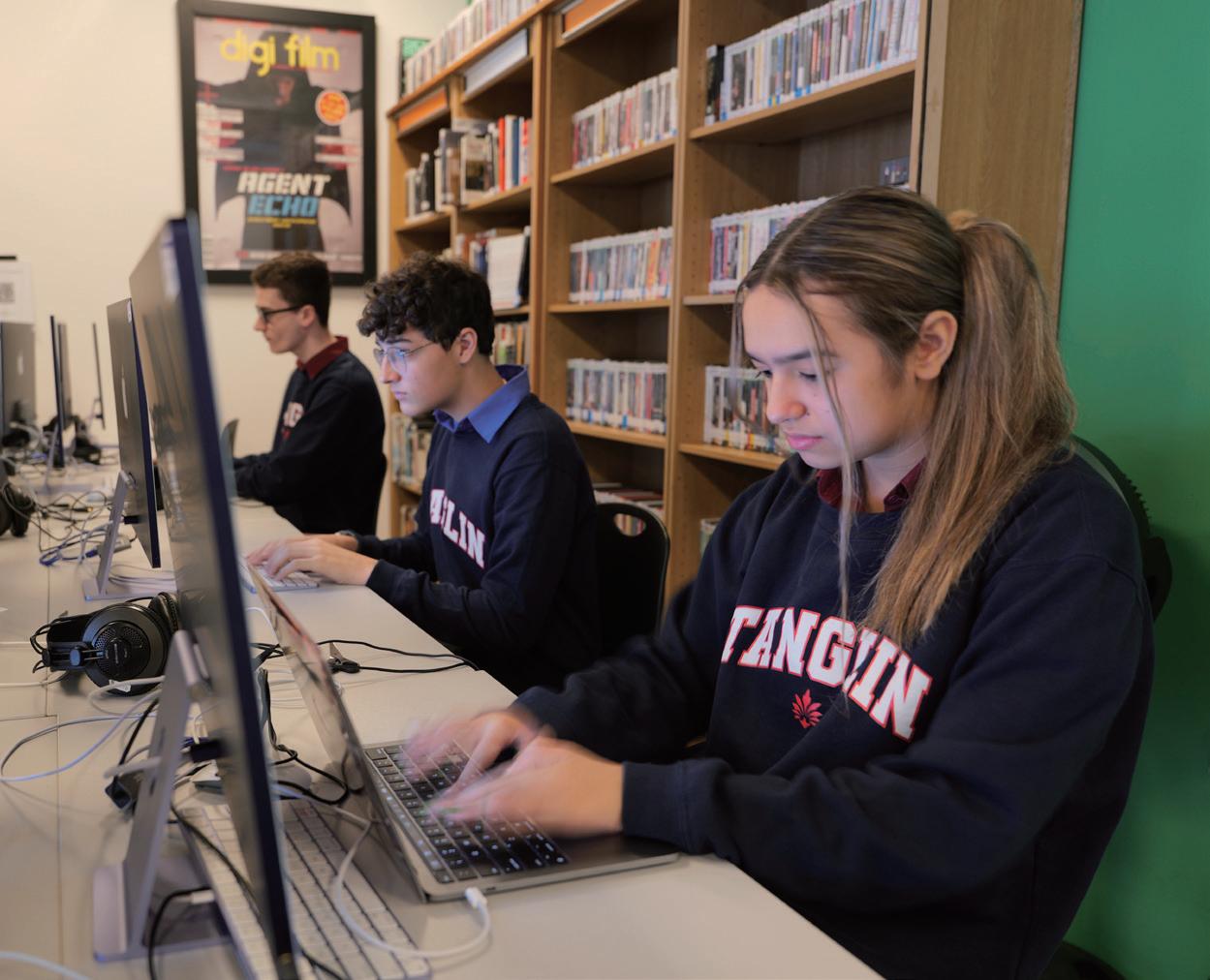





There’s a ‘new kid’ on the block, but it’s not a student – it’s the new Sixth Form jumper designed by Cameron S, the Head Team Lead for 100 Years of Excellence! What’s the story behind it? Cameron tells us more.
When I first arrived at Tanglin, I noticed the formality and sense of unity that the school uniform brings to our school. However, I found it rather unusual how there were over 30 different designs that were being worn. This included jumpers representing many sports events and musical/ drama showcases. As part of the Senior Head Team, I was further made aware of the students and teachers’ concerns about this issue. This required me to come up with a way of allowing the students to be able to wear a jumper as well as
satisfying the teachers with a clear standardised uniform. This was achieved through the implementation of a Sixth Form jumper. Upon communicating with other members of my Head Team, I approached Mr Andy Goodliffe with my proposal and upon a brief discussion, I gained his full support in driving the initiative forward.
Throughout the designing process I had the monumental task of creating a jumper that will sell and be popular amongst my peers. To achieve this, I arranged to meet with


my close friend Jihane to discuss and design 10 unique designs. From here, I discussed with our teachers and Mr Chris Seal to reduce our long list to five key jumper designs. I then went on to invite Sixth Form students to be part of a focus group in a mass email. 45 students applied and we randomly shortlisted 15 of them to attend a meeting where we collectively decided on the final design.

I remember trying it on and wearing it when I entered our Head Team meeting. The celebration and cheers from the team was incredible, all the hard work, meetings and designing paid off! A more recent memory is when I found out about how quickly the first batch of jumpers sold out. These memories as well as watching people wear them makes me very proud of my team and the legacy that we have brought to the school.
During this process, there were many people who contributed to the project’s success. From Jihane (Year 13 and designer) to Mr Tom Evans, the Director of Marcomms, Admissions & Community Relations. In fact, so many people showed their support for this project, for which I am incredibly grateful!
One of the most memorable moments of the project was when I received the first sample from the manufacturers.
“ One of the most memorable moments of the project was when I received the first sample jumper from the manufacturers.
Throughout the process students were very excited about the idea of the new jumper. Having one for Sixth Form also allowed a sense of unity among students, which made many people happy. I recall when the email was sent to all my peers regarding the new jumper in the school shop, I received many messages and videos from my friends expressing their excitement! Within a fortnight, you would struggle to not see the jumper in every group setting. People seemed to really like it and teachers were happy that the new standardised jumper eliminated the countless other designs.
Upon reflection, I am happy with the whole process of formulating the jumper. However, I would have loved to do more focus groups as they were not only key to choosing the designs but allowed for the excitement of the jumpers to begin. Having this forum to meet and discuss ideas with other students I wouldn’t necessarily communicate with has also led to many newfound friends. Overall, I am so happy with the project’s success and so grateful to all members of the community who came together to make it happen! ■
At Tanglin, we believe in the power of connection across all ages. Our 3-14 curriculum isn’t about separate schools doing their own thing; it’s about creating an ecosystem where each school interacts with one another for collective growth.

One shining example of this is our Junior and Infant Buddy system. We chat with Deputy Heads of Pastoral, Jon Pavey (Infant School) and Peter O’Brien (Junior School) to find out more.



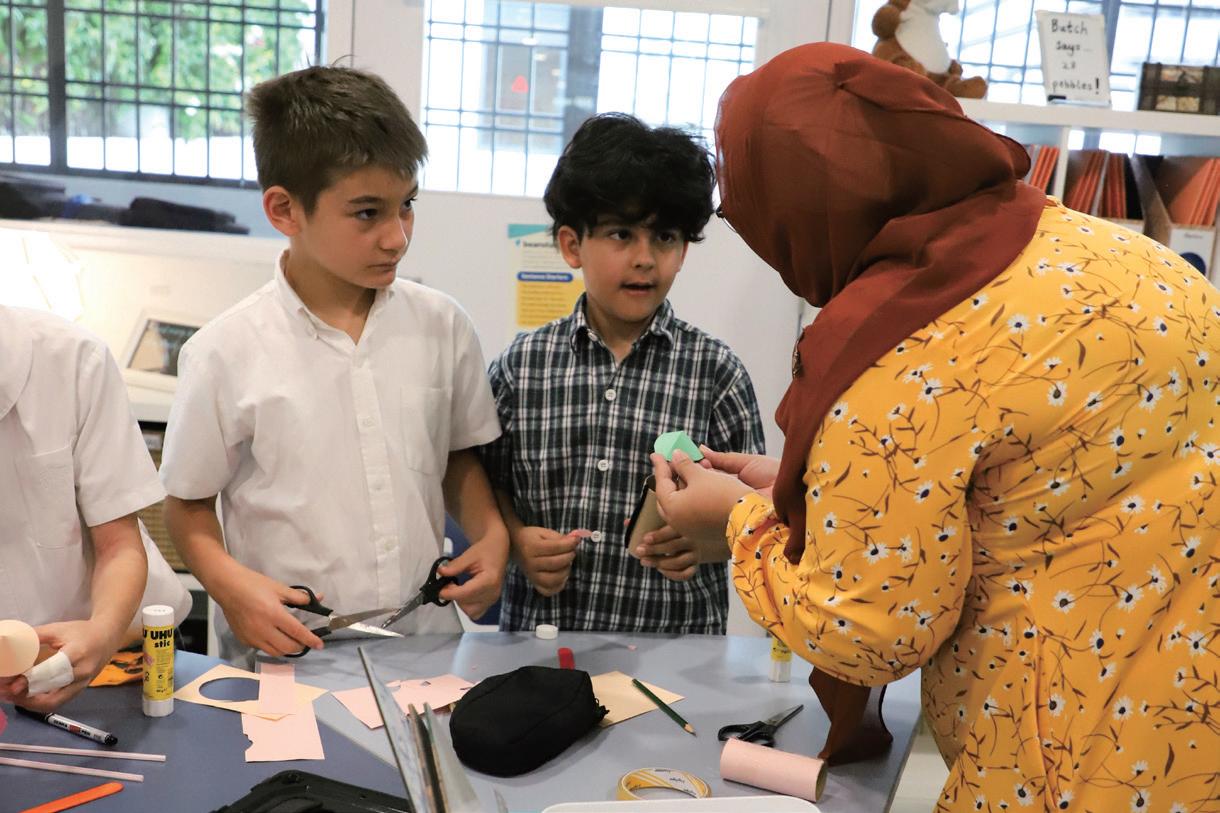

The buddy system isn’t a new concept. Throughout history, older students have always been entrusted with guiding and assisting their younger peers in various ways. At Tanglin, this powerful connection has been in place for almost 20 years since it was first initiated.
Peter: We pair up Junior and Infant classes, so they get the opportunity to build relationships and bridges across the two schools. Either the Juniors go over to an Infant class and join a lesson or playtime, or the Infants will visit a Junior class to work on a project. For example, Year 2 children teamed up with Year 5 students to build and launch a rocket during a science lesson. They worked together to plan the design, understand the forces at play and figure out how it would work.
Jon: Besides that, the Juniors and Infants also enjoy reading together, exploring social skills through play, making greetings cards, going on a treasure hunt, or solving problems during math lessons. I think it’s important to integrate both schools because it not only strengthens bonds within each school, it also prepares Infant children for the next phase of their educational journey in Junior School. The Infant children really look up to the Junior students, who wholeheartedly embrace their responsibility as role models.
Peter: Junior students also occasionally go over to Infant School to help as Playtime buddies or Nursery Helpers. These roles help develop their leadership skills and foster a sense of responsibility and empathy towards their younger peers.
Jon: It’s clear that they truly enjoy and appreciate the experience. It’s heartwarming to see how the Junior children, who used to be influenced by older students, are now excited to come over and work with their younger peers. Once they are in an Infant class, surrounded by Infant children and guided by teachers and TLAs, they take on an extra level of responsibility and seem to relish being in a teaching role. On the other hand, the Infant children eagerly anticipate the arrival of their older peers. They are always enthusiastic about showing what they can do and excited about the opportunity to learn from the Junior students.
Peter: Before COVID, we used to organise theme days like an International Day in collaboration with the Senior School. Right now, adapting it into the current timetable presents some challenges, but it’s certainly something that we can explore more in future.
Jon: We already have a number of connections with Senior students. When Senior students campaign for positions on the Head team, the Junior and Infant student councils conduct interviews with the candidates. The Seniors help support our Sports Days, the Head Students lead year group assemblies in Term 1 and our Infant dancers often perform at Senior assemblies during the Lunar New Year. We currently have two former Year 13 students supporting as interns in the Infant School. Last year we piloted a coaching programme between Year 2 and Year 10 students to support the transition to Juniors. We are expanding this in Term 3 and already have plans for Year 10 coaches to come and work with Year 2 in Term 1 to support the newly formed classes after mixing them at the end of Year 1. Some Senior students come in early on Wednesdays, before the start of their day, to help with reading.
Jon: Just the other day, some teachers shared a story about a Junior class visiting to read with the Reception children. After they finished reading the story, a once shy Reception child began to open up, eagerly leading the Juniors on a tour of their classroom and telling them all about their learning.
Peter: This kind of cross interaction is a great confidence builder for both Juniors and Infants. When Junior students work with a younger child, it brings out their nurturing instincts and fosters a sense of responsibility and leadership.
Peter: With Tanglin’s centenary celebrations coming up, there are plenty of opportunities for us to create activities for the buddy system. We might organise a street party or tailor our lessons to highlight the rich history and values that have shaped our school community over the past century.
It’s clear that Tanglin’s buddy system has been a fantastic journey of learning and friendship for our Junior and Infant students, so let’s look forward to even more enriching experiences ahead! ■
The Centenary Building is a significant milestone for Tanglin Trust School, not just for its state-of-the-art facilities but as a magnet for budding musical talents in search of nurturing. Rob Hall, Director of Music, shares how the new facilities provide the foundations for future development, including the introduction of the Tanglin Centenary Music Scholarship programme which will be introduced from August 2024 onwards.
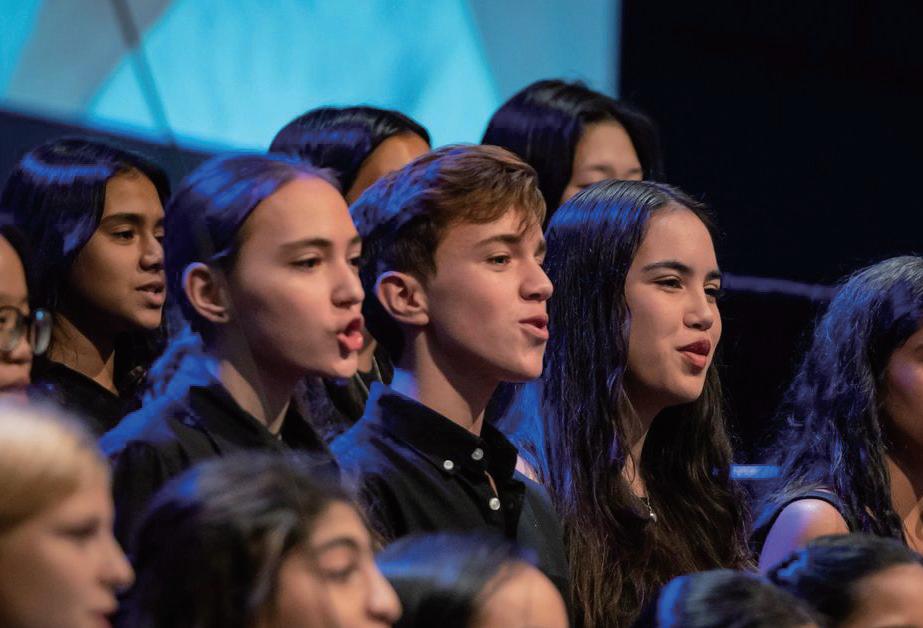

The Tanglin Centenary Building was officially opened in January 2023. Standing tall at 11 storeys, it’s an inspirational learning space that is home to a diverse range of exceptional educational facilities, including Tanglin’s new Music School. As the central hub for the entire school’s music programme, the department spans over two storeys and is the venue for weekly ensemble rehearsals, formal and informal performances, as well as individual and group lessons for students from across the Infant, Junior, and Senior schools.
This world-class facility includes two exquisitely designed performance rooms, both of which can accommodate up to 100 people. Their design is such that they are adaptable for large-scale instrumental or choral rehearsals, as well as
providing a more intimate recital space for solo or chamber music performances. Although slightly different in terms of size and purpose, both spaces have been acoustically engineered to enhance the experience of both performers and audiences alike. Both rooms are home to new Fazioli Grand Pianos.
With the facilities in place, coupled with ongoing investment to ensure that the department is given resources that are as good as, if not better than many Music Departments in universities internationally, the next stage of development for Tanglin is the introduction of Centenary Music Scholarships, launched to coincide with the start of the school’s centenary celebrations starting in August 2024. The programme will give students in the Senior School the opportunity to achieve their potential through a combination of financial support and an enhanced musical studies provision.

At Tanglin, we believe in the importance of a holistic education and the new music scholarship is an example of students demonstrating excellence outside of the classroom. We firmly believe that music can have a life-changing impact on young lives, and we want to provide a stimulating, vibrant and nurturing environment where students can develop their musical passion further. The Scholarship will require the student to demonstrate outstanding musical proficiency, a genuine passion for music, the desire to improve and develop their talents, and the commitment to perform regularly. In addition, they will be expected to inspire younger students to persevere with their musical journeys. To achieve these musical goals, the student must have several key attributes that will also complement their academic studies at Tanglin.
Many of the skills and qualities that are required in life are learned through the study of music at school.
PERSEVERANCE AND RESILIENCE: Learning a musical instrument, singing in a choir, or playing in an ensemble are all amazing experiences, but are also challenging, and at times, hugely frustrating. Our scholars will be expected to show resilience and perseverance to overcome these hurdles, maintaining focus and consistency of practice, whilst gaining the ability to reflect and learn from the setbacks that will inevitably occur from time to time. Many professional musicians reflect on a particular performance or exam that did not go according to plan, or a failed music college application as some of the most important turning points or learning experiences, using them as a stimulus or motivation to dust off and go again.
CONFIDENCE: One of the key ‘transferable skills’ a musician develops is the confidence to stand in front of an audience and genuinely perform and deliver a piece of music. Achieving musical mastery is more than just technical skill or playing the right notes; it also requires confidence and maturity to engage
the listeners through performing with understanding, nuance, and expression, making them part of the performance, and taking them on an exciting, emotional journey.
RESPONSIBILITY THROUGH LEADERSHIP AND TEAMWORK:
The collaborative nature of an ensemble or choir underscores the importance of collaboration, as musicians work together to create a harmonious performance. Scholars will be expected to display leadership qualities within their ensembles, leading by example and supporting younger musicians on their journeys.
PLANNING AND TIME MANAGEMENT: Our scholars will be expected to manage their busy schedules effectively, whether it’s their one-to-one lessons, personal practice, weekly rehearsals, or additional preparation time ahead of exams and concert performances; all of which are in addition to their academic studies and other co-curricular commitments.
CREATIVITY: Music is a profoundly creative subject, whether that be through composition, improvisation or simply in the interpretation of the notes on a page, or the reimaging of a piece of music in a different style. The programme will encourage our scholars to ‘think outside the box’ to explore their concepts and ideas.
As such, the new scholarship programme reflects Tanglin’s high expectations of its students and recognises the talent, effort, and character required to achieve musical excellence. The mentoring system will ensure that the scholars are supported »
“ Music can change the world because it can change people.
”
“ Your talent determines what you can do. Your motivation determines how much you are willing to do. Your attitude determines how well you do it.
by a dedicated member of staff, who will assist students develop many of these skills as they progress through Senior School.
What does being a Tanglin Music Scholar mean?
We expect our chosen scholars to lead by example and encourage others to enjoy and develop their own passion for music. Whether they are performing as a soloist or in an ensemble, attending concerts, or inspiring others to learn a new instrument, the Tanglin Music Scholar is expected to be a role model and ambassador of music to help create a lively musical community. They will be called upon regularly to demonstrate the excellent calibre of music at Tanglin, both with the community itself and on external visits and tours.
How will the Scholarship help students further their musical aspirations?
Like all experiences at Tanglin, the Scholarship is an opportunity for students to learn and grow. They will explore a diverse musical curriculum, which includes assisting with, leading or directing Junior ensembles as well as active participation in masterclasses, ensembles, and solo performances.
We are working hard to form connections and partnerships with several individuals and organisations across Singapore and beyond. We aim to create an annual programme of visiting artists to inspire our young musicians on their journeys. These musicians will work one-on-one with the scholars, sharing their personal experiences and expertise in such a way as to provide inspiration and motivation for our students to aspire to careers in the music industry.
In the past 18 months, we have been able to arrange visits by Igor Yuzefovich (Concertmaster of the BBC Symphony Orchestra and Singapore Symphony Orchestra); Paul Phoenix (former King’s Singer); Edward Wickham (Director of St Catherine’s College, Cambridge); Briana Corrigan (former lead singer of Beautiful South); and the Desford Colliery Band, all of whom have created lifelong memories for, and given valuable advice to our musicians. How wonderful would it be if these visiting professional musicians could tell stories of the amazing times they had as students at Tanglin? As a school and as a department, we are absolutely committed to supporting students beyond the music classroom, helping them pursue further education, or careers in music.
How will the success of the programme be measured?
There are myriad ways in which the success of the programme will be measured - both in the short and longer-term impact

on the scholars themselves and the wider Tanglin community. Quite quickly we should be able to identify if the profile of the scholars has been raised across the school - are they performing regularly in concerts, assemblies, open mornings etc? Do other students know who the music scholars are, and assuming so, how, and why? How are the scholars themselves reacting to the programme?
The first few cohorts will have plenty of scope for shaping the long-term design of the programme and adapting it to suit their individual needs and requirements, and their feedback will be invaluable moving forward. We are already considering introducing an ‘Aspiring Musicians Scheme’ targeted at potential scholars of the future, and there is plenty of scope for further developments as the programme progresses and we learn more about its successes and areas for improvement.
Our Scholars, as already mentioned, will be the role models and the ambassadors for Music at Tanglin; they will be setting the standards to which other musicians will aspire. We therefore expect to see a general increase in both the uptake of instrumental lessons and the quality of instrumental performances in Tanglin. Others will want to be part of the Scholars Programme and will therefore work hard to achieve their aspirations, thus creating a higher benchmark for future generations.
In the longer term, we hope to have a greater number of musicians who are not only studying music at GCSE/A Level/IB but are also going on to pursue their musical studies at Music Colleges, conservatoires or via Oxbridge Choral and possibly Organ scholarships. This could be through performance channels, composition, or the more traditional academic routes. For students more focused on the Rock and Pop industry, this could well involve further study in the fields of Music Technology or other similar pathways. The possibilities are endless. ■


The term ‘athletic development’ refers to the habitual development of motor abilities such as strength, power, speed, agility, coordination, balance, and endurance that provide the foundation for improved health and physical performance. In a school environment, developing these qualities should not be exclusive to ‘sport students’ only. In addition to the physical benefits, participation in an athletic development programme has many psychosocial benefits for students such as improved confidence, self-esteem, decreased stress, increased mental health, and improved academic outcomes. This highlights the importance of creating an inclusive environment where ALL students can develop, progress, and feel safe and welcome. However, for many students, gyms can be intimidating places and research has shown that the psychosocial benefits do not extend to those who experience additional stress in unwelcoming environments.
Reflecting on our approach to athletic development to ensure we have a diverse and inclusive approach that targets all students has led us to make several changes to the PE/Sports curriculum with the aim of equipping all students with the competency and confidence to participate in physical activity and sports for life. For many students, this will be their first experience of ‘working out’ so creating an inclusive environment is essential to facilitating the curiosity and enjoyment that leads to lifelong engagement in physical activity.
To ensure all students are given the opportunity to thrive on their athletic development journey through school, we focus on several areas that are key pillars of our approach. Firstly, it is important that students follow safe and age-appropriate programmes that match their age and maturation. Not all students will start or progress at the same rate but allowing students to develop and demonstrate competency across a variety of activities suitable to the individual can increase confidence and motivation.
Secondly, creating an environment where students are encouraged to be curious and explore a variety of movements and activities can support them in developing intrinsic motivation and confidence. This can also enhance their learning, physical performance, and adherence to physical activity. Finally, offering multiple pathways that allow students to access different levels of support on their athletic development journey, such as specific sports team sessions or age-specific CCAs, can allow the students the comfort and feeling of belonging through connecting with friends and teammates to share their athletic development experience.
By actively promoting inclusivity, we can create an environment that allows all students the opportunity to thrive and feel supported, whether their aim is to play sport at a higher level or simply lead a healthy active life. ■
Do you have questions about athletic development at Tanglin? You can contact Tom Clarke at tom.clarke@tts.edu.sg.
If your child is on a sports performance squad, they may have participated in Tanglin’s IMPACT programme since the beginning of the year. What is it and how does it benefit students? Let’s hear more about it from Tom Clarke, Tanglin’s Head of Athletic Development.

The beginning of the academic year marked the launch of our IMPACT programme, a targeted approach to education and support for students in our sports performance squads, as well as those competing at a high/national level in their sport. Throughout the programme, we have been able to give students opportunities within the school day to access individual support and facilities. IMPACT students have additional access to the athletic development gym during CCAs and sport mornings where they can work on a specific programme. They also have access to our physio triage ‘dropin’, which runs every Monday, should they need to ask our in-house physios about an injury. We also implemented a new breakfast initiative for our senior athletes who participate in morning training. Students can now register in advance and, for a nominal fee, enjoy a nutritious breakfast designed to aid in their post-training recovery and provide essential fuel for the day ahead.
This allows them to optimise their school day and avoid scheduling extra sessions before or after school, which would otherwise add to their already demanding training schedule. Tennis student-athlete Eduardo is one of the students who benefitted. He said, “I have been able to use my sport morning to work on my strength training in the AD (Athletic Development) gym. This has been beneficial, as I needed a period
Below: The Girls Touch team taking part in a fitness testing session in the build-up to their SEASAC tournament


to build my strength and mobility, particularly after injuring my back. I am now back to full fitness and looking to compete on the ITF Junior Tour”.
We have also welcomed Bevan and Vanessa from Singapore Physio to run our in-house physiotherapy clinic. Aside from providing 1-1 physiotherapy services to our students, they have assisted with injury reporting, functional screening and have been a great contact point for parents who may face tough decisions regarding injuries and potential surgery or rehab options. With Singapore Physio onsite, students enjoy the convenience of scheduling their physiotherapy sessions during school hours, allowing them to seamlessly integrate treatment into their breaks, sport, PE, or co-curricular activities (CCA) periods. Creating a circle of care around the student, we ensure a holistic approach to their recovery, with physiotherapists, athletic development coaches, sports coaches, and parents all working in harmony to facilitate the student’s return to full fitness in a safe and timely manner.
Connor, who was unfortunate to sustain an ankle injury during day 1 of SEASAC Football in November, tells us, “(I’m) grateful for the dedicated physiotherapist who has played a pivotal role in my ankle recovery, providing me with guidance and support. Their tailored approach and encouragement made all the difference in restoring my mobility and confidence resulting in me being fit and ready for the Harrow 7s Football tournament in March.”
Inside the AD gym, we have been able
to make use of our VALD performance equipment to analyse and assess students’ physical performance and injury risk through sport specific testing sessions. This gives students an insight into their strengths and areas for improvement. The data is utilised to inform the athletes’ training programmes, which they will complete as part of their team strength and conditioning sessions.
Throughout the year, many of our teams have attended sessions led by sports psychologist Dr Jay-Lee Nair. She has a competitive background in high-level sports and is the author of Good Sport , a guide for parents and coaches who support young athletes. During the sessions, the students discuss practical strategies and models to manage sports competition and performance through guided self-analysis.
Director of Aquatics, Bobby Hurley, has this to say about Dr Jay-Lee’s sessions, “Dr Jay-Lee’s sessions have been invaluable to the Merlions programme, firstly understanding their natural feelings on competition day and then delivering actionable thoughts and cues to ready them for the next race. Her unique approach towards psychological readiness has also provided me with a new perspective on coaching, leading to positive shifts from both coach and athlete in which we are already seeing the benefits”.
We are excited to continue enhancing and refining the IMPACT programme to offer our student-athletes the utmost support. ■

Gina Torok, a graduate from the Class of 2023 and a recent intern with Tanglin’s Marcomms team, shares what it’s like to be part of the school’s clockwork.
I’ve been at Tanglin since Year 9, and it’s been a wonderful journey that recently concluded with my internship with the school’s Marcomms team. Since I was planning to study media and communications at university, I had asked Ms Zoe Williams (Head of Careers & University Counselling) if she knew of any internships in communications I could do. She suggested Tanglin’s Marcomms team, so I applied and the rest, as they say, is history.
Before I started my internship, I was a little apprehensive because I didn’t know what to expect, but all that dread was for nothing because I met some of the loveliest people who led me through one of the best experiences I ever had. During my first week, I familiarised myself with the responsibilities of each team member and I realised that each role was like a gear in a clock that worked together in sync to make Tanglin tick.
To be frank, in the beginning, I hadn’t perceived these roles as particularly significant from a student’s perspective, but I now know better. I also spent the first and second week running around the school trying different things such as photography, attending meetings, discussing the annual appeal, and even shadowing a school tour.
In the meantime, I was put in charge of a project to create a Christmas playlist consisting of songs chosen by teachers across the school. This was when I realised that there were a few hoops to jump through before a project gets the green light. I had to do my research on the legal aspects and confirm whether it was permissible to share it with a wider audience. Once I shared my findings with my supervisor and got the allclear from him, I provided the teachers with a form to gather a list of Christmas songs for the playlist. Initially, the idea was
to create a separate playlist for each school. However, once we received people’s suggested songs, I instead consolidated them into a single playlist that was shared with the Tanglin community before Christmas break.
Another job I had was helping with the school’s Christmas fair. It was something I looked forward to as I loved it when I was a student. The vendors came in to set up their booths the evening before the fair and it was a completely new experience for me because I hadn’t interacted with people outside of Tanglin before this. This introduced a few challenges I hadn’t encountered earlier in my internship as I found myself dealing with members of the public who weren’t as accommodating as the school staff. On that evening, we ran into some complications, and I found myself having to make some quick decisions on the spot as well as enhance my communication skills – something that I hadn’t extensively developed during my internship until then. Although this was the most hectic part of my internship, it enabled me to gain a deeper appreciation for the Events team and better understand the extensive planning and efforts that go into running a school event.
Overall, my internship was a very pleasant experience. I loved how it perfectly aligns with my university course so I was able to find out more about what I would be studying. Funnily enough, even though I didn’t finalise my decision for my major before this internship, it helped me decide that I enjoy working with people and made me comfortable with my choice of choosing Communications and Media. This internship also gave me a newfound appreciation for all the members of staff who work behind the scenes and don’t always get the credit that they should. As students, we never know how much work goes on outside of our learning and it was fascinating to see it in person. ■



“It was great to have Gina’s support in the run-up to one of school’s largest events and having her behind the scenes as she worked on a multitude of tasks and contributed to the overall success of the event!”
- Jenny Aylen, Friends of Tanglin Executive“Having Gina around brought back memories of my own work experience days! She was a great addition to the team, and I was always impressed with her composure and confidence when sharing her point of view in meetings, and her ability to confidently tackle so many diverse tasks being thrown at her. I liked the way she drew on her comms experience from her days as a Tanglin student, such as organising the Leavers’ Ball and coordinating the Year 13 yearbook. She was able to share her learnings and experience and apply them effectively in her work experience.”
- Amy Anderson, Content MarketerOver the years, many have come and gone from Tanglin, yet their connection to the Tanglin Family endures, regardless of where life takes them. Today, we reconnect with some of our cherished former teachers and staff to discover the remarkable journeys they’ve embarked on since their time at Tanglin.
 David Woods, Head of Senior School (2004-2009)
David Woods, Head of Senior School (2004-2009)
“I left Tanglin in December 2009 and became Campus and Secondary Principal at the La Chataigneraie campus of the International School of Geneva (often known as ‘Ecolint’). It is a 3 to 18 school with about 1500 students. Ecolint has three sites with 4,500 students in total and is the school where the IB Diploma was first conceived of and taught in the 1970s, so in the IB world, it is something of a ‘rock star’ school to work at. In August 2020, I moved to my current school, Hockerill Anglo European College in the UK where I am also principal. The College is a state school of about 950 students, which offers day and boarding places and, very unusually for UK state schools, only the IB Diploma post-16.”
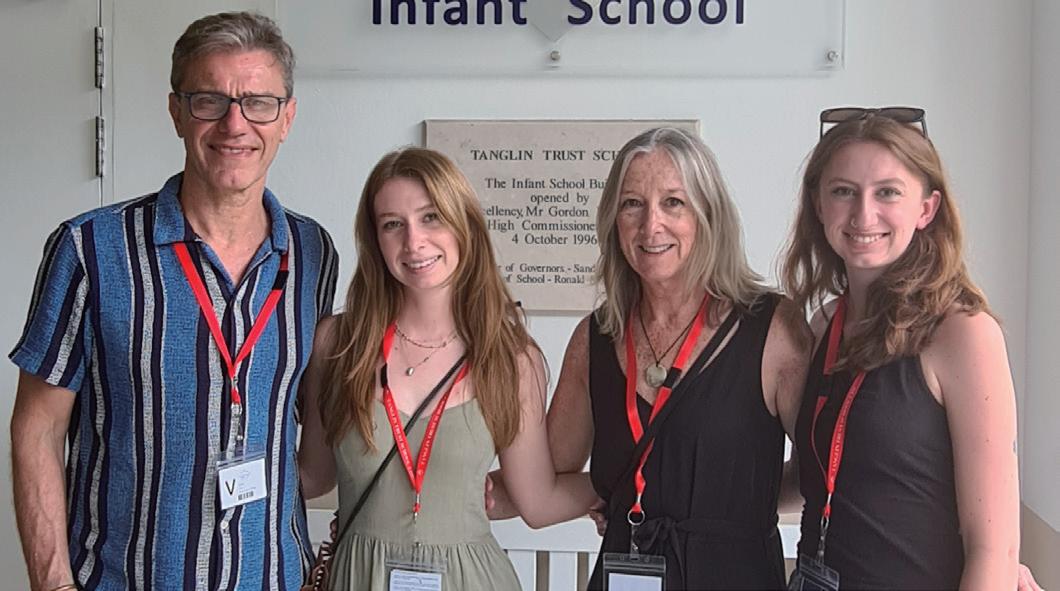
Above: David with his family
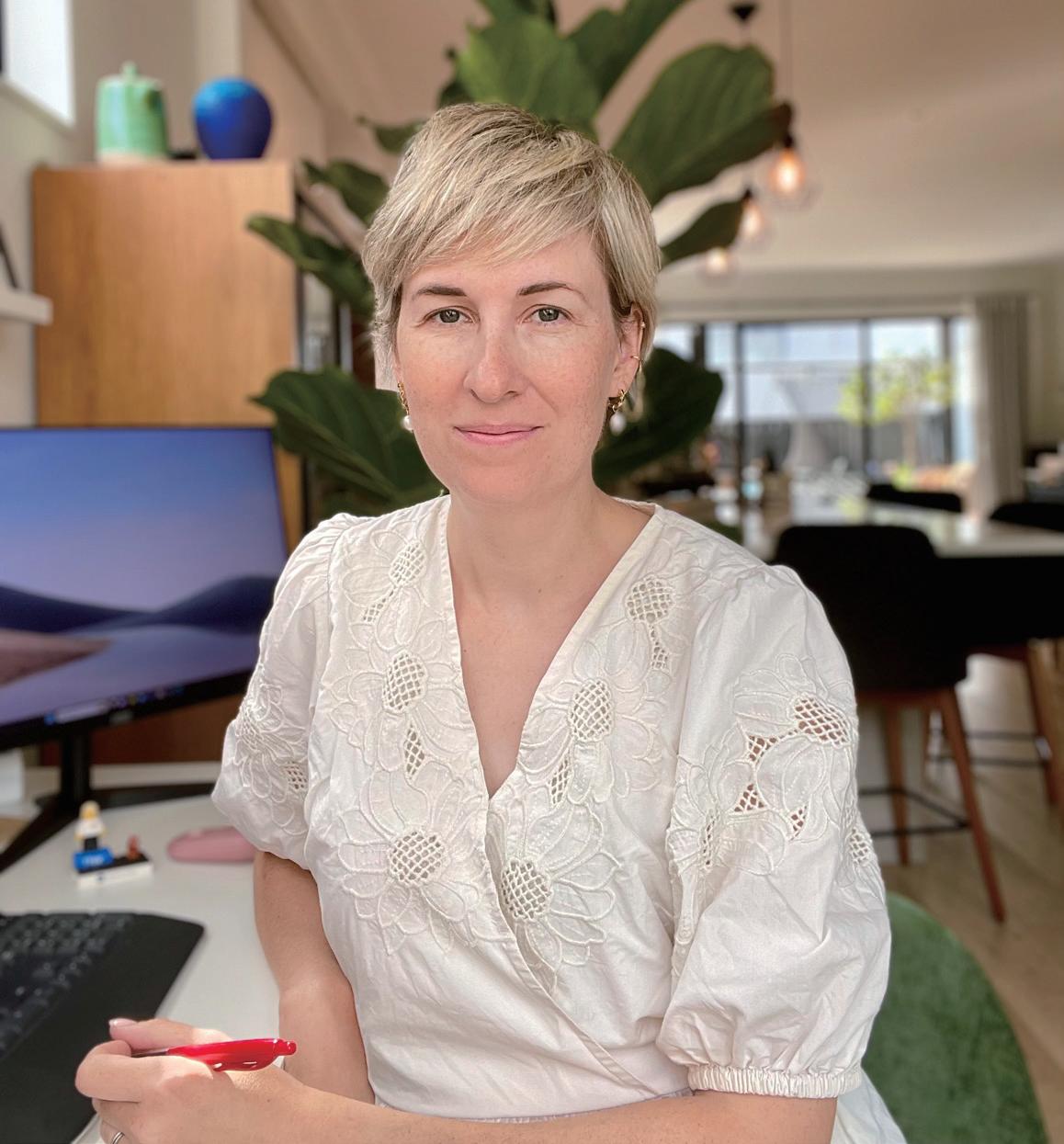

“I arrived at Tanglin from Paris in 2001 as a Music teacher in the Senior School alongside Emma Northin. I remember Ron Stones telling me when he offered me the job that I’d feel at home at Tanglin as there was a Curran Hall in the Infant school, which was named after one of the governors before the three schools were rebuilt. In any case, I loved working in the Music department as Assistant Director of Music where many fond memories were made. One of the fondest memories was setting up a Jazz Band comprising the best instrumentalists in the school. Some of the students ended up working in the music industry: at Carnegie Hall, signed with Universal Records, producing their own music, and working for Artist Management agencies in London. We had a lot of fun recording a couple of albums: the first was at the old analogue Panasonic Studio in Commonwealth and the second at a digital studio in Chinatown. The British High Commissioner at the time, Alan Collins, wrote the band a letter asking where he could buy a CD and invited the band to perform at several events at the High Commission for members of the Royal Family and other dignitaries. I left Tanglin eight years later in 2009 to take up a Head of Faculty position at the British School in Tokyo to be closer to my wife’s family. We lived in Tokyo until 2016 before moving to Henley-on-Thames where I have been Director of Music at Shiplake College ever since. In 2020 I graduated with a Master’s in Educational Leadership and once the COVID years became a distant memory, I embarked on a search for another role in secondary education. I was delighted to be offered the role of Founding Director of Sixth Form at King’s College in Bangkok that will commence in August this year when it opens the last of its new buildings in the heart of the city. My family and I are excited to be moving back to Southeast Asia and we definitely plan on a trip or two back to Singapore where my wife and I first met and where our daughter was born!”
“My time at Tanglin was short but memorable for all sorts of reasons. My 18 months as Publications Editor began the week all non-essential workers in Singapore were asked to work from home, due to the COVID-19 pandemic. So, for many months, I ‘learned’ Tanglin from the dining room table, with my two preschoolers virtually at my feet. I felt very honoured that the community trusted me to tell its stories in print. Nowadays, I live in Auckland, New Zealand, where I’m a lead editor at an international EdTech company. In the last year, both my daughters have started school, so I’m experiencing the magic of campus all over again, this time as a parent. I still keep up with Tanglin’s news and applaud its continuing progress from afar. I will always be proud to have been a tiny part of its history.”
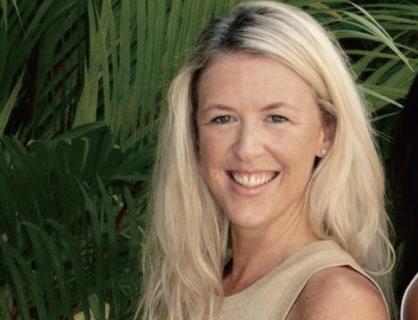
“After leaving Tanglin we moved to Melbourne, and I am now Director of Marketing & Communications at Scotch College in Melbourne. We have a long history at Tanglin, my husband went to the school as a child, then our children were there (our son from Reception till Year 8, and our daughter from Nursery to Year 5). I loved working at Tanglin - I was Director of Admissions and before that, I was the Communications Manager. My time at Tanglin was one of the most enjoyable of my career and I really miss the people - it really is a very special place.” ■
Were you part of the Tanglin Family as a faculty member or staff? We want to hear from you! Drop us an email at communications@tts.edu.sg and let us know what you’ve been up to with your most recent photo.



















One of the major events in the Alumni calendar is the annual London Alumni Event. Held in November in central London each year, it aims to bring Alumni together from across the years to reconnect with former school mates and teachers. Alumni travel not only from all over the UK, but many make time to travel from around the world! Shakila Samuel, Head of Community Relations, gives us the lowdown.
On 18 November 2023, we hosted over 500 Alumni at The Fable - our largest turnout ever for our London event.
We took an entire restaurant (over two floors) to host our Alumni – with the younger and older cohorts hosted on different floors, making it easier for them to meet friends from their cohort years. It was wonderful to see the interactions of the Alumni over the years and for them to recognise Alumni they knew as young Sixth Formers or Junior students, now all grown up and still very grateful for their time at Tanglin. Alumni who had just started university (and missing their Tanglin friends) enjoyed being able to reconnect again with their friends from Singapore.
At our event in November, we had a strong group of former staff in attendance – many who now teach in the UK or have retired but still came to meet their former students and colleagues, making this a very special gathering for all Alumni. We had several former heads of school and former CEO Peter Derby-Crook in attendance. It was also heartwarming to have Geraldine Chandran (the Chandran Hall is named after her) attend the event again. She was a former Head of Infants and had worked at Tanglin for over 31 years. She continues to be a big draw at these events.
With the launch of the Tanglin 15 Club in early 2023 (for all staff past and present who have worked at least 15 years at Tanglin), we were delighted to be able to also present the long-service gifts to 13 former staff who came to the London event. Combined, they had over 200 years of work experience at Tanglin!
In addition to the Alumni team, the event was also supported by the presence of current teachers, our CEO, Craig Considine, and Chair of Governors, Dominic Nixon. It gave us the chance to share about what was taking place and the plans for the school back in Singapore. The buzz around the London event was of course Tanglin’s Centenary, which will be celebrated in the next school year. Many shared how they were looking forward to attending the event in November 2024 and being able to meet more Alumni through the years. ■
Friday, 15 November
Young Alumni Reunion
2021 to 2024 Cohorts
Saturday, 16 November Centenary Celebration
All Alumni
What lies beyond graduation? It’s a question that inevitably weighs on the minds of every Year 13 at Tanglin as they navigate exams, university applications, and chart their future paths. What trajectories have our Tanglin alumni pursued and how have these choices shaped their journeys?
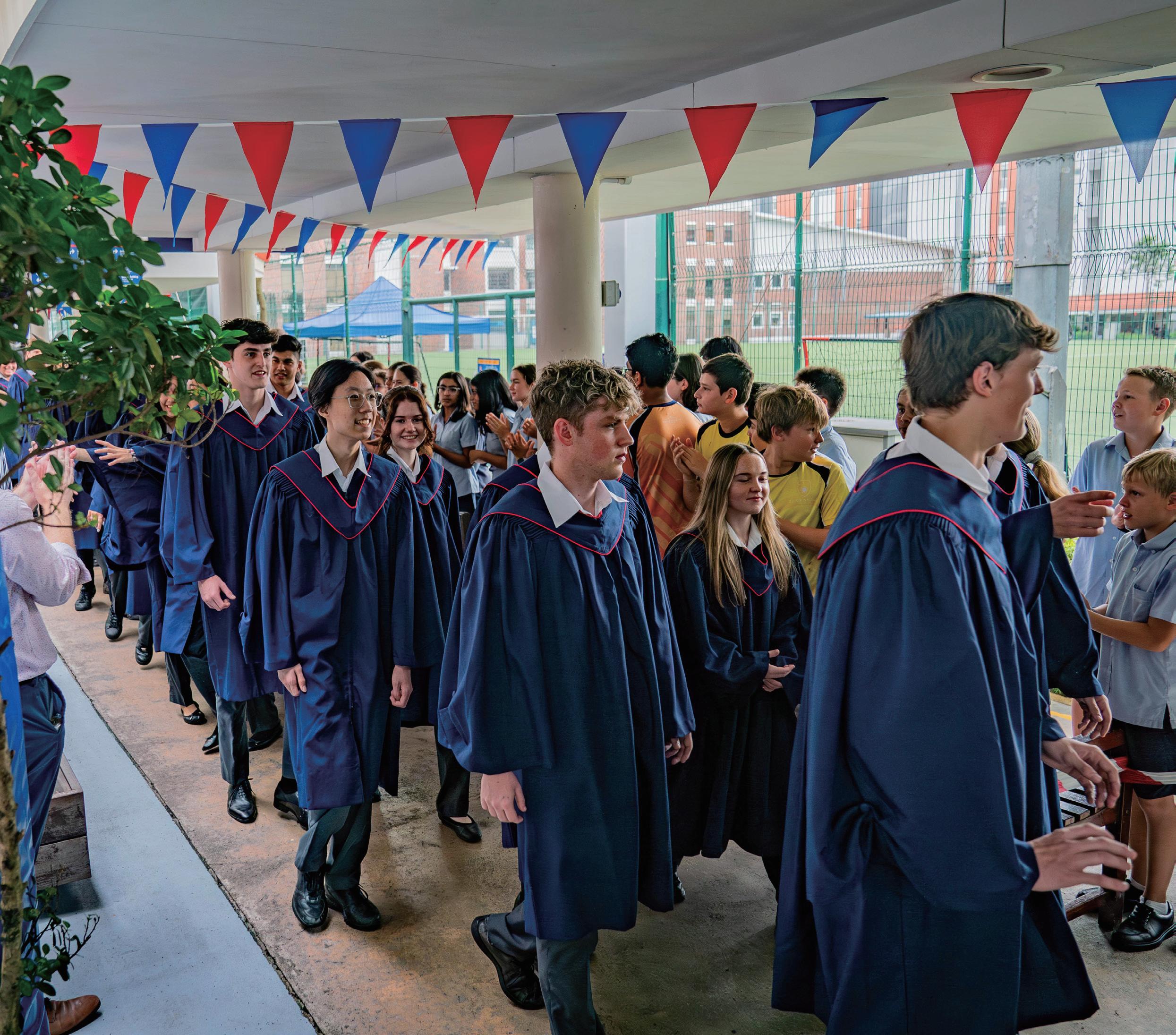

Vedaant, who graduated from Tanglin in 2023, is following the well-trodden path of many Singaporean citizens or permanent residents as he fulfils his national service obligations in the 3rd Singapore Guards Battalion. “I was born in Mumbai, India, but I moved to Singapore when I was four months old, so I feel like I’m practically Singaporean now,” he shares with a warm smile.
What was your Tanglin journey like?
I started Year 7 at Tanglin in 2017 and it was such an amazing experience. I got to explore everything I wanted to do, especially during my A levels when I had the opportunity to pick the subjects that really resonated with me such as Film Studies, Drama and English Literature. I chose these subjects because I plan to take Film & TV Production in university. In fact, I’ve applied to five universities already!
Which universities did you apply to?
New York University (NYU), University of Southern California (USC), University of California (UCLA), LMU School of Film and Television, and Chapman University. I was eventually accepted into NYU, which was my first choice.
How did you make the time to do your university applications despite your busy NS schedule?
I woke up at 3.30am every morning and utilised the devices we were provided for online learning. Although I didn’t get much sleep, it felt really great when I managed to complete my applications! Getting accepted into NYU was especially cathartic because I was rejected on my first application in Year 13. I hope this will motivate students currently facing rejection from their dream universities because they will have another chance to reapply during their NS or gap year like I did. This gives you a second chance to present yourself as a strong candidate and improve your chances of acceptance!
Why didn’t you choose to defer NS?
I wanted to get it over and done with, because I didn’t want to go to university, have a really good time, do all my things, build my career, and then have to go back to fulfil my NS obligations. I’m still quite young so it doesn’t really disrupt too much of my life.
NS is known for being physically demanding. How did you prepare for it?
During my actual A levels, I’d go to the Clementi stadium every alternate day to practise for my Individual Physical Proficiency Test (IPPT) because if you pass it, you get two months shaved off your NS. I was confident of passing the sit-ups and push-ups, but I hated running my entire life, so I decided to train for it. I slowly reduced my running time over two months and eventually passed it. Fun fact: two of my sergeants are also Tanglin Alumni serving their NS currently. They are Pathania and Kieran Scherer from the Class of 2022. Given its size, it’s so incredibly rare to find three Tanglin graduates in the same company!
What about the mental aspect?
I watched Ah Boys to Men and it’s actually incredibly accurate! Even the funny stuff that happens in the movie – things like if you mess around with your buddies in the bunk, you’d all get into trouble. I also chatted with my friends who were still doing NS.
What kind of advice do you have for someone who is preparing for NS?
Talk to your friends if they are still in NS and train yourself physically. If you haven’t been doing sports etc, then start now because you get to shave off two months off NS if you pass. Just imagine how much you can do within that time! I, for one, spent it doing a couple of internships at Tanglin and a local film production company. You can also watch videos online to see what NS guys do to prepare themselves mentally. Another tip I have is to try fulfilling your external commitments as much as possible before you enter NS. For example, you’d want to complete your university applications beforehand because NS is already strenuous enough; you don’t want to add more stress to yourself.
I’d also encourage people to keep up their optimism because it’ll really help you get through the tough times easier. Reframe your negative thoughts by seeing the positives in your experience such as getting fitter, building mental toughness, learning the value of camaraderie etc, and you’ll be happier. You may not be able to change the inevitable, but you can definitely change your perspectives about it. Your buddies will also be influenced by your optimism, so it’s beneficial all around. At one point or another, you might feel super sad or annoyed that your freedom has been taken away but remember that it’s not your entire life. NS is just a PART of your life. Make post-NS plans that are related to your passions, so you have something to look forward to unless you plan to sign on. For example, I hope to join a theatre company after NS, so I’ve been emailing people and gotten some replies.
In other words, prepare yourself as much as you can!
Now that Vedaant has shared his NS story. Let’s find out how Tanglin supports and prepares our students for NS. Zoe Williams (Head of Careers & University Counselling) explains, “students who are planning for National Service are encouraged to check the MINDEF Singapore website for enlistment details. They can also attend alumni talks, join school activities like the Duke of Edinburgh programme and the running club led by Mark Scoular, Head of Year 7, or use the school gym to improve their physical condition.”

Amelia Geddes Cohort 2024
Amelia may not have graduated yet, but she has already planned her gap year down to a tee. We catch up with the busy Year 13 student and her mother Fiona to learn more.
Why did you decide to do a gap year?
I’ve always been interested in doing a gap year since I was young. I love travelling and exploring the world. I had originally planned to take a gap year after university, but after discussing it with my friends and family, I decided there was little point in waiting.
How did you plan it?
To prepare, I consulted with my university counsellor, Ms Zoe Williams, and outlined a month-by-month plan. This, along with additional research, confirmed my decision to take a gap year. My gap year promises to be both busy and fulfilling. I’ll begin by working on superyachts in the Mediterranean during the first summer. After that, I’ll volunteer in Tanzania and South Africa before I move on to work a ski season in the Alps. And finally, I’ll cap off the year with a solo trip around Europe. This plan allows me to combine work and travel while I engage in activities that I’m passionate about.
Any challenges or concerns during the planning process?
One of the biggest challenges I face involves ensuring my safety while travelling. To address this, I make sure to choose companies with robust safety protocols especially during the initial stages of my trip while I develop my confidence and social awareness. Another concern I have is the prospect of being away from my family for the first time. This leaves me feeling lonely, so we plan to meet up on the first Christmas a few months after I begin my travels as well as during the second summer. This way, I know I’d definitely be seeing my family again at some point. I am so excited for this experience to begin because I really believe it
will help me grow holistically by developing my personal skills, gaining valuable professional experience, and exposing me to new cultures and environments.
What’s your advice for someone who is considering doing a gap year?
My biggest piece of advice is to do lots of research and make sure you know what you want to do and that you’re fully committed. The more excited you are, the easier the whole process becomes.
Thanks for sharing your exciting gap year plans, Amelia! What does her mother, Fiona, think about it?
I’ve undertaken two backpacking stints myself, the first right after university and the second about four years into my career. The life experience and broad perspective you gain from such adventures are unsurpassed so when Amelia expressed her desire to take a gap year, I had no hesitation in supporting her. Our children grow up in a very privileged and protective bubble here in Singapore. The gap year will enable Amelia to develop a greater understanding and appreciation of the world and the realities of the struggles that many face. She will need to be financially astute to ensure her budget lasts and be willing to take on work to earn money along the way, hopefully building up transferable skill sets. She will be out of her comfort zone in many situations and will need to make decisions on who to spend time with, who to trust, and learn when she herself needs downtime.
Safety is the key concern, but we’ve had a lot of discussions on how to keep herself safe and what to do in emergencies. She is very sensible and has good instincts and has done a lot of research that she has talked me through, so I don’t worry too much. The benefits far outweigh the risks. I’m also helping to research some of the working options and insurance options for her, and together we have done a boat captain course that should help towards her plans to be a deckhand. When she departs for her gap year, I’m sure we’ll stay in touch regularly, and I’ll be able to follow her adventures on TikTok! We will be meeting her in South Africa for Christmas, which I’m already looking forward to. For summer 2025, she plans to have her little sister (who will then be 16) join her on a backpack trip around Europe together. I’m sure I’ll feel that I’m missing out and may try to join them for a short stint too!
No gap year is the same - some children want to travel, some children want more time to decide on whether University is the right path for them, and some want an opportunity to work or relax. You know your child best, and whether the gap year they are seeking is right for their balance of maturity, temperament, and comfort. Ultimately, our children are 18 now (or soon will be), and adults in their own right, so we can listen and advise if we think the decision is the right or wrong one for them, but if they make a different choice, supporting them in that choice is important.
Thank you, Fiona! Now let’s hear from Tanglin Alumna Amena Boyd. Like Amelia, she opted to do a gap year before enrolling in university, so she too has an interesting story to share!

I decided to take a gap year before even applying to university, as I felt I needed a break from academics after the rigour of A Levels. I also wanted to ‘get out into the world’ a bit before settling down into three more years of study. COVID lockdown exacerbated this feeling (I graduated in 2020), and in the end my hand was forced anyway as I missed my university places after not being able to sit my A Level exam due to the pandemic. My parents had both taken gap years before university, as had many older family and friends, so actually taking a gap year had been set as the norm throughout my life. I had always just assumed I would take one but being ‘forced’ to by my results outcome made me realise that it was in fact the right choice for me. I couldn’t believe how quickly freshers week rolled around for my friends who weren’t taking a gap year and was incredibly glad I had this year to explore and grow up a bit – I felt way too young to be heading straight off to uni!
I decided to structure my gap year into two halves. I was hoping to work the first half over summer and autumn, have Christmas at home and then travel for the second half. However, that second half was still a big question mark due to COVID travel restrictions, so I resolved to be flexible and just see what opportunities
“I matured a lot and learned a huge amount about who I am, how I like to spend my time, and who I like to hang out with.
presented themselves. In the end, I spent my summer working in a café in Singapore, before moving to London to intern and babysit for three to four months. I lived with my best friend there and had enormous fun – we were both living independently for the first time, and we loved every minute of it.
After Christmas, I managed to get onto a volunteering/travel programme in Costa Rica called the Leap. This was a two-month structured programme, which was not at all my plan. I had hoped to backpack with a few friends, but unfortunately no one close to me was also taking a gap year. Since I was essentially solo travelling during a very unstable time, this seemed the only feasible way to get abroad. I ended up meeting lovely people during the programme and spending an extra month travelling Costa Rica with them once the programme was completed. The programme worked well for me due to the specific circumstances and I had a wonderful time, but honestly, I’m not sure I would recommend it – the best bit about travelling is freedom and spontaneity and my travels were lacking a little! After Costa Rica, I spent a month in Spain on an intensive language course. This was probably the highlight of my year, as tourism was at an all-time low. I got to spend two weeks in Madrid, two weeks in Malaga and got to know both cities very well whilst improving my Spanish and living with a close friend.
How do you stay engaged and motivated?
There were definitely times that I felt demotivated during my gap year – fluctuating lockdown restrictions, travel bans making it difficult to find ways to go travelling, etc. It sometimes made me just want to sit at home for the rest of the year and do nothing. However, instead of waiting for the ‘perfect opportunity’, I forced myself out of my comfort zone as soon as something promising came along. And, at the end of the day, I still felt that even if I had sat at home all year doing nothing, taking a gap year would have still been the right decision, so I might as well make the most of it.
What were some challenges?
Probably the biggest challenge I faced was quite specific to taking my gap year over 2020/21. I ended up doing hotel quarantine alone twice in order to re-enter Singapore and see my family. This was obviously quite an intense experience both times I did it, and really tested my mental strength! However, I actually learned a lot about how to spend time just with myself, look after my mental health and picked up a few new hobbies off the back of having to find ways to creatively fill my time. I think spending time alone was really valuable and not something I would take back.
Thanks, Amena. The Careers & University Counselling team works with each student to work out a suitable gap year plan. However, what motivates students to take a gap year instead of heading straight for university? Zoe explains, “some students may choose a gap year for economic reasons, while others may feel they’re not quite ready for the next stage. The gap year is thus a valuable opportunity for personal growth and work experience, especially for those planning a vocational degree. It’s also not uncommon for students to re-sit exams or reapply to universities during their gap year. That being said, students intending to take a gap year are encouraged to actively apply the skills they intend to use in their upcoming degree, as failing to do so could mean a lost opportunity.” ■
We dug into the archives and here is what we found in Tanglin’s long history of excellence.
Did you enjoy our Tanglin Christmas Spotify playlist over the festive season last year? If the seasonal songs chosen by Tanglin staff put you in the festive mood, then don’t forget to check out the Christmas record that was released by Tanglin Preparatory students back in 1969 too!


Scan the QR code to listen to the Tanglin Christmas Hits 2023
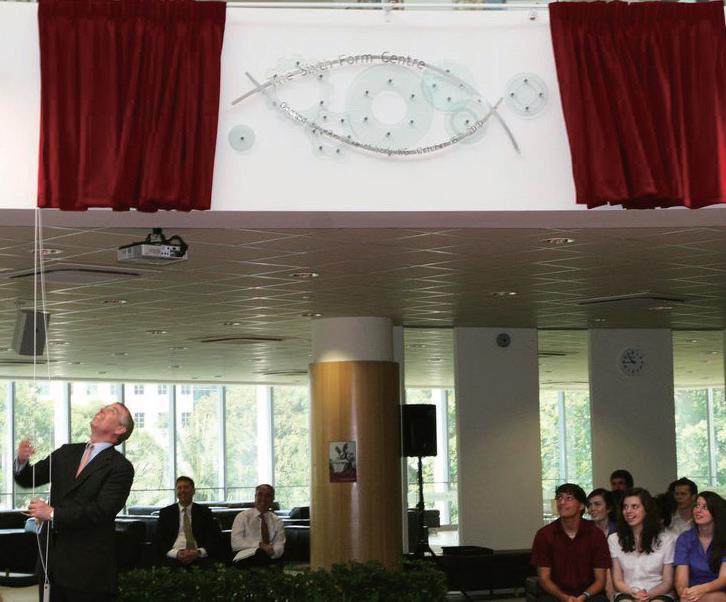
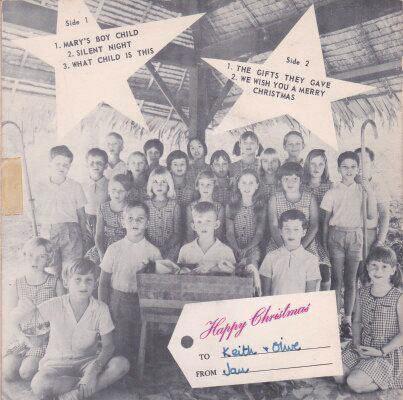

As the oldest British international school in Southeast Asia, Tanglin has had many esteemed visitors over the years. They include H.R.H. the Duchess of Gloucester who visited Tanglin Preparatory School in 1966, John Major the former Prime Minister of the United Kingdom in 2009, the Duke of York who opened the new Sixth Form

Centre and Senior Library in 2010, and perhaps the most unforgettable of all, Her Majesty Queen Elizabeth II’s visit in 2006! If you were one of the people in the excited crowd, we want to hear from you. Email us at alumni@tts.edu.sg to share what it’s like to ‘rub shoulders’ with prominent figures such as Her Majesty Queen Elizabeth.
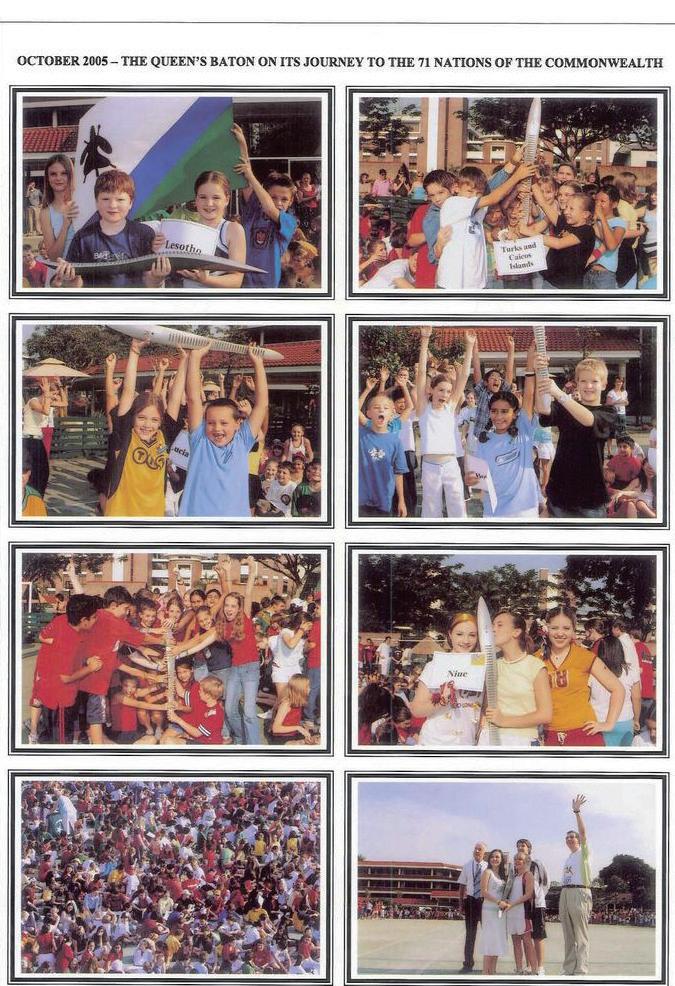
And while it’s not exactly a human visitor, the Queen’s baton also stopped by Tanglin in 2005 as it made its way around 71 countries during the Queen’s Baton Relay for Melbourne Commonwealth Games. Such fun!
Do you have photos or stories from Tanglin’s rich and long history you want to share with us? Then drop us a note at alumni@tts.edu.sg. ■

Tanglin is gearing up for the Centenary of a lifetime, but who is the lady who will put our history in order and plan the school’s biggest celebrations?
Meet Anna Buset, our Centenary Manager.
I’ve only lived in Singapore for 18 months; I’m half English and half German but have lived in the UK all my life! One and a half years ago, my family was given the opportunity to move to Singapore. With a true sense of adventure and a ‘surely we’ll never regret this’ attitude, I moved here with my husband and two children. My girls were lucky enough to get into Tanglin and are currently in Year 4 and Year 7. In the UK, I lived in Kingston Upon Thames - cycling the school run along the River every day and working for a boutique speaker agency in London finding incredible expert speakers for client events.
WHY DID YOU DECIDE TO TAKE ON THE CENTENARY
I heard Craig talk about the Centenary in one of his CEO Breakfasts and as soon as he mentioned it, I knew that it was the perfect role for me! I’ve been working in Events, project management and Operations for over 20 years and had been given such a warm welcome to Tanglin that I was very interested in the role and joining the school community. I loved the idea of working at the school. I was coming in every day on the school run and thought that it would be a fabulous celebration to be part of.
WHAT DOES A CENTENARY MANAGER DO AND WHAT DO YOU HOPE TO ACCOMPLISH WITH IT?
I have the very lucky job of overseeing and project managing all the Centenary Celebrations – from August 2024 through to 2025, we are going to celebrate all parts of our history in so many exciting ways. We want to start by looking back at our incredible founder, showcase the different buildings and
locations we’ve been in and most importantly celebrate the children, teachers, and staff of Tanglin through the years. We want to celebrate our past but also so importantly, we want to look to our future – what do the next 100 years hold for us? I’m hoping to leave the school with a year of memorable events but also an excitement about what is to come.
CAN YOU SHARE ANY INTERESTING STORIES OR ARTIFACTS FROM THE SCHOOL’S HISTORY THAT YOU HAVE COME ACROSS IN YOUR WORK?
I’ve been hiding away in the school’s archive room every Friday afternoon for a few weeks now. Did you know we have photos of one of the first five children who attended the school in 1925? Can you imagine that we also have slices of the original Banyan tree that had to be moved to make way for the Berrick building? I’ve found original school badges and pins as well as bits of uniform, which all tell a unique story. At a conservative guess, there are over 10,000 photographs and slides of students through the age, and I’ve found myself very lost in the archive flipping through the photos. We hope to be able to show some of these next year!
WHAT CHALLENGES DO YOU FACE IN MANAGING THE SCHOOL’S HISTORY ARCHIVES, AND HOW DO YOU ADDRESS THEM?
The biggest challenge is dating and identifying photographs of children and events. I wish people had thought about me in the future, sitting on the Archive Room floor flipping through hundreds of photos and wishing that they had put the date on the back of at least some of the photos. It’s great fun guessing

decades by looking at the hairstyles, shoes or uniform of the children and teachers, but it’s not an exact science! We also have some very precious items that won’t survive the hot and humid climate of Singapore so we’re working with archivists to make sure that everything is looked after and preserved for the next 100 years.
HOW DO YOU COLLABORATE WITH OTHER DEPARTMENTS OR ORGANISATIONS TO ENHANCE THE SCHOOL’S HISTORY ARCHIVES?
One of the first projects that we undertook as part of our Centenary celebrations, was to work with Singapore History Consultants who were tasked with writing the full History of Tanglin. This is now an incredible 700-page document – full of photos, first hand stories and official documents. It was all thanks to the due diligence of past students, staff, and heads of schools here at Tanglin that we have anything at all in our archive. So, with this document, we want everyone to read our history but also know that everyone here is part of our future too.
HOW DO YOU PLAN TO PROMOTE THE IMPORTANCE OF PRESERVING THE SCHOOL’S HISTORY?
In the archive, I’ve found a Year 1 child’s report card from 1977. I’d love us all to think that in the future, it could be one of our current children’s reports that are being looked at by the Bicentennial Manager! Throughout the year, we will celebrate different aspects of our history, and these will be timely reminders to the whole community of the importance


of keeping records. It’s only because of the letters, photos, and documents that we have, do we know some of these stories.
HOW DO YOU THINK THE SCHOOL’S HISTORY ARCHIVES CONTRIBUTE TO THE OVERALL IDENTITY AND CULTURE OF THE SCHOOL?
Walk around the school and there are already many places where you will see old photographs of our past schools, students and of course our founder, Miss Griff. I found a staircase in the Junior building that has sports day photos from the 90s. It just shows to me that wherever you are, we are always celebrating where we came from, and I think this is a true marker of our identity and culture. The children walk past these photos every day and I can’t help but think that this creates a sense of pride in belonging – that they belong to something that has such a deep-rooted history, and they are now part of it and the future.
HOW DO YOU PLAN TO CELEBRATE SIGNIFICANT MILESTONES IN THE SCHOOL’S HISTORY?
There are going to be events that everyone in our community can get involved in. We will engage with the youngest children right up to our Seniors, parents, and Alumni. We will exhibit some of the best bits from our Archive, the children will be performing and getting involved in Drama and musical productions. The highlight of the year will be a Centenary Gala next year and there’s a very exciting project that seeks to tell 100 Tanglin Tales. And finally, there has to be cake! It’s a birthday and our youngest members of the community will be enjoying a special Birthday Party to celebrate this great occasion (with cake of course!). ■

There are several versions of the phrase “fortune favours the bold” but they all mean the same thing: success comes to those who take risks. Year 12’s Alicia embodies this when she sent a cold email to Natasha Damodaran, Managing Director of Vogue Singapore, after a talk at The Institute in September last year. Read on to find out what happened next.
Like many third culture kids, Alicia was born in Hong Kong and joined Tanglin in late November 2021. As an ardent self-starter, she has many diverse pursuits. Alicia said, “My favourite subjects in school are HL Physics and Film. I love physics because it allows me to understand how the world around me works. I attended summer schools at Phillips Exeter and Imperial Global Summer School to delve into quantum physics, relativity, and astrophysics, as well as gain valuable lab work experience. I also collaborated with NUS’s QuTalent Team to produce videos on quantum physics. When I was younger, I started various donut/snack businesses in school. Although they didn’t pan out, it instilled an entrepreneurial spirit in me. I was a student council member too, helping to organise school socials, charity weeks, yearbooks etc. I joined various clubs where I learned public speaking skills that allowed me to win ‘Best Presenter’ at Tanglin’s Hackathon as well as first place at the Bangkok world scholars cup global round.”
Alicia engages in such pursuits because they keep her busy and help build a competitive portfolio for future university applications. Given this proactive approach, it’s no surprise that she seized the initiative to email Natasha Damodaran, the Managing Director of Vogue Singapore, after a talk at The Institute. She said, “I went up to the speakers, asked a couple of questions like how the magazine makes money etc and let them know I was available if they needed help at their Next in Vogue event. I think it left a good impression because when I dropped them an email with my resume, I got a positive reply from Natasha! I had no expectations, so this was a pleasant surprise and obviously too good an opportunity to pass up!”
With only a two-week school break for the internship, Alicia relished the opportunity to work with one of the world’s foremost fashion magazines. She was assigned to the marketing team, where she handled administrative tasks and took on the role of ushering guests at one of their events.
“My supervisors were really accommodating, so they allowed me to network freely. I had the privilege of meeting inspiring individuals like Grace Park, the Co-Founder and President of DocDoc, the world’s first patient intelligence company. Since such opportunities don’t come every day, I made sure to collect their contact details so I could reach out to them in future,” Alicia said with a smile.

“Everyone is super nice and very down to earth. Even though it could get stressful during times like the run-up to an event, everyone kept their cool and worked hard. It was a very healthy working environment; nothing like the movie The Devil Wears Prada !”
Alicia’s naturally outgoing personally makes her easily likeable to those she encounters, but what gives her the courage to approach people or send cold emails? This is what she has to say, “I try my best to create opportunities for myself because ultimately, the worst response I can receive is a ‘no’. That’s why I believe that if you want to try something, just go for it!”
What advice does she have for shy people then? After some thoughtful consideration, Alicia shared, “I’ve noticed that adults tend to be more lenient with young people. If you take the initiative to approach someone and start a conversation, they often respond warmly and may even extend opportunities. I guess it’s because adults view kids as eager to learn rather than trying to take advantage.
“Another thing that I’ve observed is that professionals who are experts in their fields often welcome conversations with young people because they want to influence the next generation and spark their interest in the industry. So yeah, I’d say just take the leap and see where it goes. After all, the worst they can say is ‘no’.”
“I’d say the most valuable aspect is the connections I’ve built. I had the opportunity to meet many amazing people who are often willing to provide mentorship. I also gained useful skills while working in the office such as how to use a spreadsheet effectively, emailing people professionally, outsourcing work and interacting with your bosses. It’s very different from being a student because you get a lot more independence, but you are also required to figure things out yourself. Luckily my supervisor was the nicest lady ever. She was always there to help and give me advice.” ■
According to Lao Tzu, “a journey of a thousand miles begins with a single step,” which is precisely what Year 12 students Alicia, Ayush, and Krishiv have done. They scored an internship with Quantum Talent, an online learning platform supported by the National Quantum Computing Hub (NQCH) Singapore and its partners. The intrepid trio shares more with us.

We are all deeply interested in the field of physics. That’s why in the summer of 2023, we embarked on our first trip to the National University of Singapore (NUS) to meet Dr Kuldip Singh to chat about career and university prospects. We had originally planned for it to be a short meeting, but it unexpectedly stretched into a multi-hour session as we passionately discussed cutting-edge experimental research and the confounding implications of some ideas currently being proposed by theoretical physicists.
After finding out that we have a mutual interest in exploring quantum physics further, Dr Singh referred us to QuTalent – an online platform that is dedicated to fostering new and growing communities by sharing information about quantum computing locally and internationally. Led by Dr Jibo and Dr Han Rui, the team was looking for student interns to help create an accessible and user-friendly website. This platform aims to share simplified information on quantum mechanics and quantum computing. They already had a treasure trove of short, catchy videos on topics like the Travelling Salesman Problem and they had also recorded several lecture series on basic physics! After all, in the near future, which career won’t be part of the wide, ever-expanding mesh of the quantum world?
We were so excited to contribute to this initiative, we even made a video about Schrödinger’s Cat, a thought experiment that often comes up in discussions. If you’re not familiar with it, you might want to look it up before continuing. Schrodinger’s Cat is an experiment that is often misunderstood and misquoted. Popular science articles, videos, and podcasts on the web often present it in a mystical and perplexing way, adding to the confusion. We were also once misled by it and if you once asked us what one can conclude from this thought experiment, we would have said that the only possible explanation was that the cat was both dead and alive at the same time until you opened the box.
Eager to discover the fallacy in our argument, we toiled endlessly and tried to get our heads around foreign-looking Math and Physics concepts for months. It was sheer joy for us but a chance meeting with our hero Dr Berge Englert elevated the experience even further. He was a professor who had first introduced us to
After finding out that we have a mutual interest in exploring quantum physics further, Dr Singh referred us to QuTalent – an online platform that is dedicated to fostering new and growing communities by sharing information about quantum computing locally and internationally.
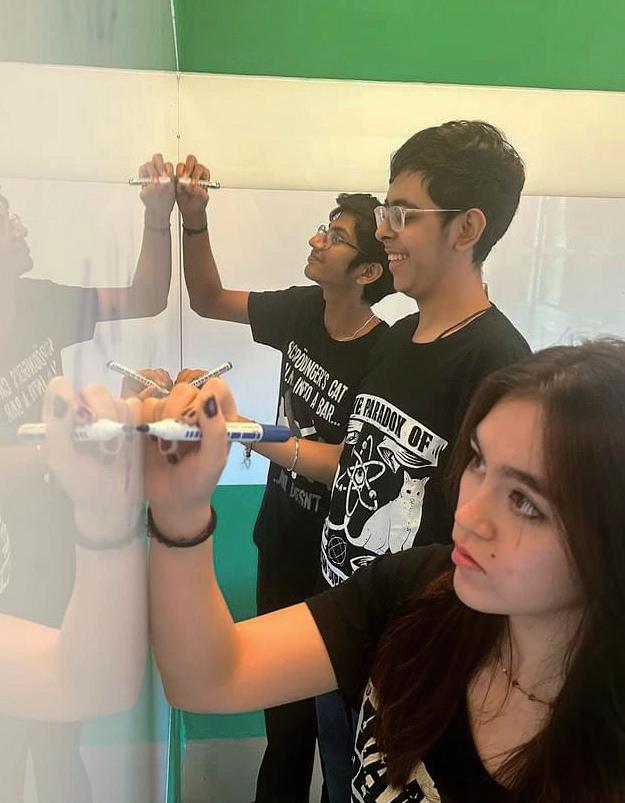
the maths behind quantum mechanics through one of his lecture series. We bombarded him with question after question, creating an unrelenting flood of inquiries that finally satisfied our curiosity after several enriching sessions. We have now gained a working knowledge of the basics of quantum mechanics. Spoiler alert: the cat cannot be both dead and alive at the same time.
Creating the script was another adventure: we had to strike the right balance between informing the public of the truth behind the experiment and keeping in mind that most of our audience had yet to be exposed to the intricacies of Dirac notation. Krishiv was in charge of writing a succinct, yet informative script. He explains, “I like to think of the process as unravelling the thread of an argument down a wall. Everything you say must stream out of your initial point, you cannot forget to regularly tie knots to strong foundations, and at the end, you must reach the floor: a sense of stability and resolution stemming from your initial claim.”
The final stages consisted of the drawing and editing process. Ayush spearheaded the drawing effort, and with his quick prototyping and sketching abilities, we were able to zoom through this stage. Finally, Alicia is now in the process of compiling the images and animating our video.
This experience has truly transformed how we understand physics. Before, we were only exposed to classical physics that were built on the foundations of Pierre Simon Marquis de Laplace and Isaac Newton’s belief that the Universe’s past and future states could easily be predicted as long as one knows the current state of every particle comprising it. There are certainly mysteries beyond our grasp, but physics isn’t a campfire tale to be marvelled at, nor is it a zoo where we simply observe curated depictions of reality. ■

How does Tanglin nurture future-ready students? In addition to its 3-14 curriculum and diverse co-curricular programme, the school also dedicates resources to The Institute.
Here’s how students have benefitted from its programmes so far.
Regardless of the times we are in, the world is perpetually in a state of flux. Since change is the only constant in this day and age, it’s important to be prepared for the future. This means being able to adapt to new situations, learn new things and work well with others. After all, future-ready individuals are more likely to be successful in their careers, have better relationships and contribute positively to their communities. This is precisely the aim of The Institute@Tanglin, which offers a diverse array of programmes to cultivate these essential attributes. Since its establishment in 2022, The Institute has been actively organising numerous workshops, talks and student projects. Here are some of the key highlights:
David Faulkner, MBE OLY, an accomplished professional with extensive experience in managing high-performance teams across sports, international institutions, and corporate sectors, led sessions focusing on athlete development, Diversity, Equity, and Inclusion (DEI), and wellbeing in sport. He also shared insights from his Olympic journey and emphasised the importance of teamwork and personal best.
For the past two years, the 16-week Innovation Programme run by The Institute in collaboration with SC Ventures (SCV), Standard Chartered’s innovation, fintech investment and ventures arm, is an example of one of the Institute’s key aims of offering Tanglin students real-world learning opportunities. The rigorous programme has been tailored by SC Ventures to introduce ‘Human Centred Design Thinking Skills’. It’s a fantastic opportunity for students to test their thinking beyond the academic, and consider the broader issues that businesses face in today’s shifting marketplace. Students not only had to expand their critical thinking they also experienced what it would be like to work in a real business environment.
This year, the SCV team received 32 idea submissions from across Year 12. Four teams were shortlisted, and they completed a specially tailored bootcamp where they received mentoring and coaching from SCV innovation coaches led by Julia Erakovic, the SCV Intrapreneurship Lead. The students eventually presented their ideas at the Paypal offices in front of an extensive panel of SCV, PayPal, Argor Capital, and Microsoft business leaders as well as senior Tanglin staff and their parents. Julia Erakovic summed up the event perfectly by saying, “the pitching was top class! It was a real pleasure to support Tanglin again. It is great
to see our Intrapreneurship Programme teach these students to take risks, be resilient, adapt and learn from failure in creating their solutions – exactly what is needed for the next generation of entrepreneurs. We hope to see them pursue their passions and take their ideas into reality.”
An innovative educational programme developed by Shaping Learning for Shell, NXplorers introduces young minds to the complex and creative thinking skills for them to become positive agents of change. In 2022, a group of Year 12 students discovered the programme and decided to pursue it under the guidance of their physics specialist teacher, Chris Dech. The group focused their research on how they could efficiently harness Singapore’s water resources as a potential renewable energy source and collaborated with industry experts to design micro-turbine generators in storm drains. It has since evolved into a CCA offering and this year, we saw three teams of Sixth Form students make their first pitches at The Hive.
Aside from providing students with opportunities to learn, The Institute also celebrates student excellence in the form of the Exhibition of Excellence in Student Research. The showcase included students’ core curricular work such as Extended Essay (EE), Extended Project Qualification (EPQ), Year 9 Foundation project, CAS (Creativity, Activity & Service) as well as co-curricular and external competitions/projects such as the World Scholars Cup.
Probably The Institute’s most glamorous and futuristic event to date, the talk provided valuable insights on the potential for the fashion industry to drive changes by merging science, technology, AI, and creativity. Led by Petra Sekhar (Programme Director of the Vogue Foundation) and Natasha Damodaran (Managing Director of Vogue Singapore), the session was a fascinating introduction to the challenging and innovative world of fashion for Tanglin students and the wider community. The speakers really connected with our audience, and helped them understand what it takes to run a magazine these days. Disruption and innovation are central to this process and ensures the Vogue brand and the people who work for it continue to evolve through continuous learning to remain relevant in fashion, media and publishing today.
Just before last year’s Polling Day Public Holiday, we welcomed Dr Vinika Rao to the Institute at Tanglin. As the Executive Director at INSEAD Africa Initiative and Hoffmann Global Institute for Business and Society, Asia, as well as being a veteran of the Corporate World, Dr Rao seamlessly explained the complex and multi-layered subject of DEI and ESG and why sustainability and diversity initiatives need to go hand in with inclusion. Through her research, Dr Rao guides global organisations on Diversity and Inclusion and Sustainability initiatives and believes that business has the potential to be a force for good, led by managers who value social impact and are committed to the UN Sustainability Development Goals.
The Institute also welcomed Dr Darian McBain, world-recognised expert, speaker, and author on sustainability, ESG, supply chains, business human rights and sustainable finance. Dr McBain was
the first Chief Sustainability Officer at MAS and is recognised by the United Nations as a Sustainable Development Goal (SDG) Pioneer. Her talk explained how the Blue Economy is inextricably linked to the Green Economy, as the Ocean is our largest carbon sink, and hence has a significant impact on our temperatures and carbon dioxide levels. Yet, the financial investment in this goal is the lowest out of all the UN SDGs, primarily because there is not enough information and data on the impact of the ocean on climate change and hence, investors cannot assess the financial risks of investment in this space. This provoked much discussion and questions from the students as they grappled with the multi-disciplinary issues of sustainable fishing, overfishing, piracy, pollution, rising sea levels, impact on communities with strong cultural affinity with the ocean and carbon nature-based solutions.
What if robots could help people walk again? Janette Tartabini from Ekso Bionics demonstrated this by introducing Junior and Senior students as well as parents to EKSO, a robotic ekoskeleton designed to help neuro-rehab patients walk again. Fascinated by how the robot controlled and guided their classmates to walk, sit, stand, and even squat, Junior students were able to witness how technology can be combined with science, engineering, and maths in real life while Senior students had a chance to conduct research for their medical technology design project or studying the role of robots in the field of neurobiology.
These were just a few of the many events that The Institute has organised over the past years and our students have definitely benefited from it. Take Year 12’s Alicia for instance. Attending the talk led by Vogue Singapore not only enabled her to gain fascinating insights into the challenging and innovative world of fashion, she also managed to snag an internship (pg 46) with the fashion magazine giant! Another Year 12 student also has this to say about sustainable finance and the ocean economy talk, “the topic of blue finance and ESG was really interesting because I’ve always had an interest in climate change and environmental issues as well as how finance can play a role in those issues.”
Sohini Brandon-King, Director of Scholarship, Inquiry and Partnerships, tells us, “it has been a remarkable year for the Institute and I hope the everyone who attended our events has enjoyed discussions with our speakers and that students have stretched their thinking and learning through our programmes with a taste of the ‘real world.’ Look out for our future events, we hope to see you there!” ■
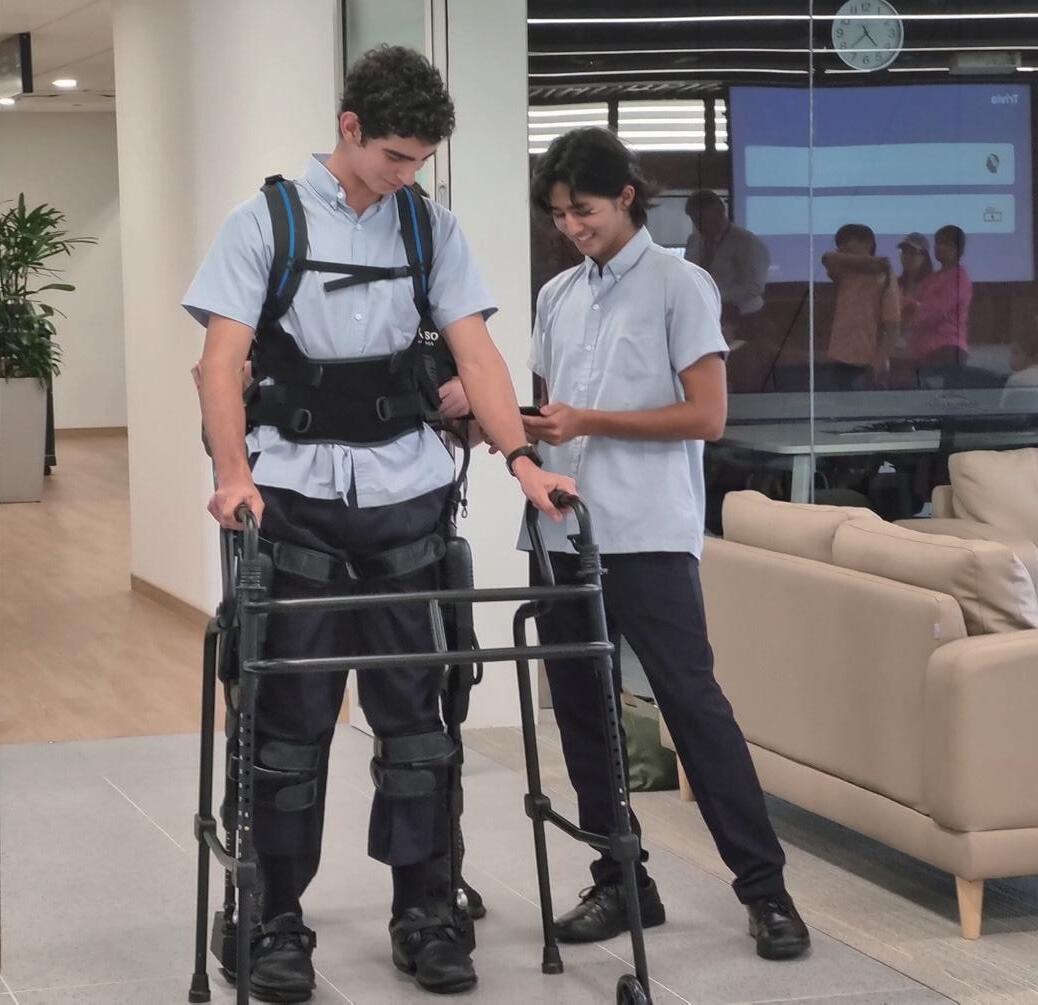

In a dazzling showcase, Tanglin presented one of its most opulent productions to date, bringing the vibrant spirit of Chicago to Tanglin! Read on to find out how this ambitious theatre production came to life at Tanglin.
Directors Claire Connor, Rob Hall, Helen Owain, and Anita Sprague, alongside a cast and crew of over a hundred senior students and staff, mesmerised audiences with their rendition of Kander & Ebb’s iconic and award-winning musical. They explored themes of fame, fortune, and the irresistible allure of jazz, bringing the production to life in a captivating fashion.
Tanglin students have an enduring passion for musical theatre and dance, and this production was no exception. Led by students from Years 10 to 13, the company was formed with incredible commitment and infectious energy. The students’ remarkable talent allowed the directors to double-cast the main roles, enabling each individual to bring their distinct interpretation to this legendary musical.
The main cast was bolstered by an exceptional ensemble, with each student playing a crucial role in breathing life into the iconic musical. Night after night, the entire company received enthusiastic applause from the audience members who were immersed in the captivating drama that was Roxie and Velma’s infamous rivalry - a testament to the audience’s appreciation of the months of dedication and hard work invested by both cast and crew.
Rob Hall, Head of Music, and Helen Owain, Assistant Head of Music, collaborated as Musical Directors for the production. Rob skilfully conducted the live orchestra, which seamlessly integrated professional, student, and teacher musicians. Meanwhile, Helen directed the supporting ensemble singers backstage. This musical collaboration flawlessly captured the essence of Jazz Age.
Inspired by Fosse and Reinking’s original choreography for Chicago, Olivia M (Tanglin’s Dance Captain) worked with Abigail
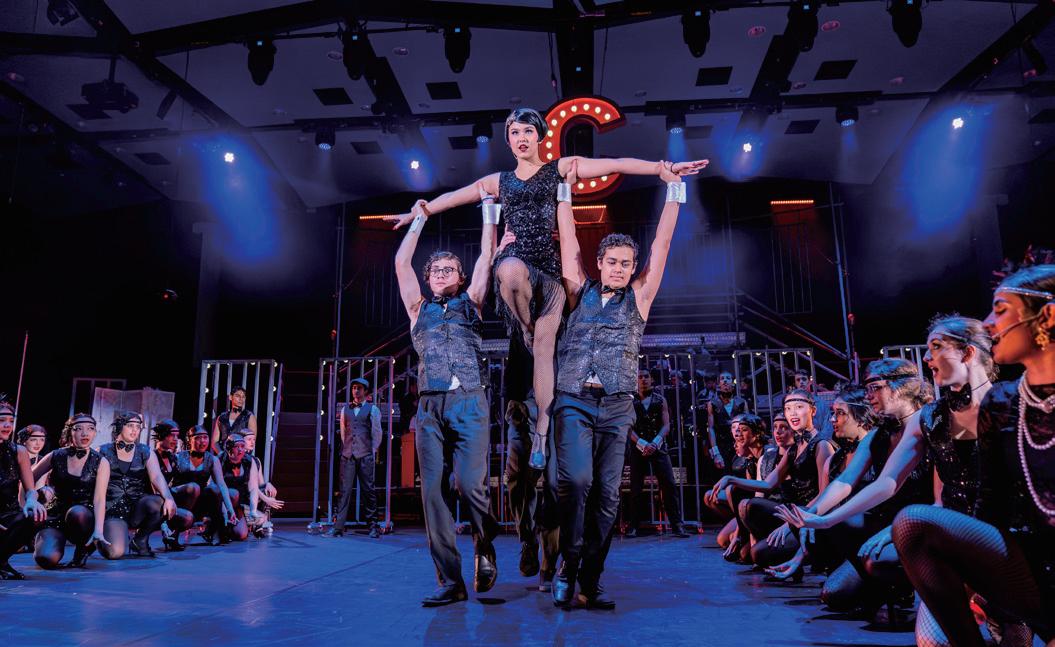



D and Aysha M to masterfully recreate and vividly portray the inherent challenges of attention and the dual nature of spectacle – two pivotal themes in the musical. Under the guidance of Anita Sprague, the choreography, both stylised and elegant, captivated audiences with its dazzling execution, serving as a powerful embodiment of the musical’s core concepts.
The visual concept for the performance brilliantly captured the ambience of downtown 1920s Chicago and the unique setting of Cook County Jail. Crafted and envisioned by Tom Edwards, the striking set seamlessly established the scene, prominently featuring the iconic ‘C’ of Chicago as the focal point. Claire Connor, Zickry, and Tom Edwards added depth to the narrative and immersed the audience in the intricacies of the characters’ world with their skilful execution of lighting.
The 1920s, renowned for its iconic fashion, represented an era of opulence before the onset of the Great Depression triggered by the stock market crash of 1929. In this vibrant backdrop, wardrobe manager Claudia Lim curated a wardrobe that encapsulated the glamour and razzle-dazzle of the period, adorned with a plethora of sequins. Collaborating with student designers Eliza H and Renee L, the result was a dazzling showcase of the Roaring Twenties’ style.
The production collaborated with staff member Annie Rusell, whose exceptional skills as a professional hairstylist, wig dresser, and makeup artist for TV, film, theatre, and opera added a unique layer to the production. Her inspiring designs seamlessly unified the vision for the show, bringing authenticity and flair to the performers’ appearance.
The 2024 Senior production was an incredibly captivating show, featuring a stunning score, and was a remarkable showcase of the artistry in musical theatre. Tanglin can proudly say it rocked Chicago! ■
“Third Culture Kids” (TCKs) is a well-known term, but it’s also part of a broader category called “Cross-Cultural Kids” (CCKs). TCKs grow up in a different culture from their parents’, but CCKs experience a variety of cultures. So, while all TCKs are CCKs, not all CCKs are TCKs. With that in mind, what are some common challenges they might encounter and how does Tanglin help them address such issues?
According to Ruth Van Reken, co-author of Third Culture Kids: Growing Up Among Worlds and author of Letters Never Sent, CCKs are a “person who has lived in—or meaningfully interacted with—two or more cultural environments for a significant period of time during developmental years”. Like TCKs, CCKs may encounter the following challenges:
• Cultural identity
• Feelings of rootlessness or disconnection
• Social isolation
• Feelings of loss
• Language and cultural barriers
Growing up in different cultures can be tough for CCKs since they often grapple with questions of identity and the pressure to fit in. Year 10’s Coco, for example, tells us that moving to a new country made her feel really sad and disconnected. But she finds comfort in her parents and staying in touch with old friends helps too. There are other issues as well. A CCK may experience reverse culture shock
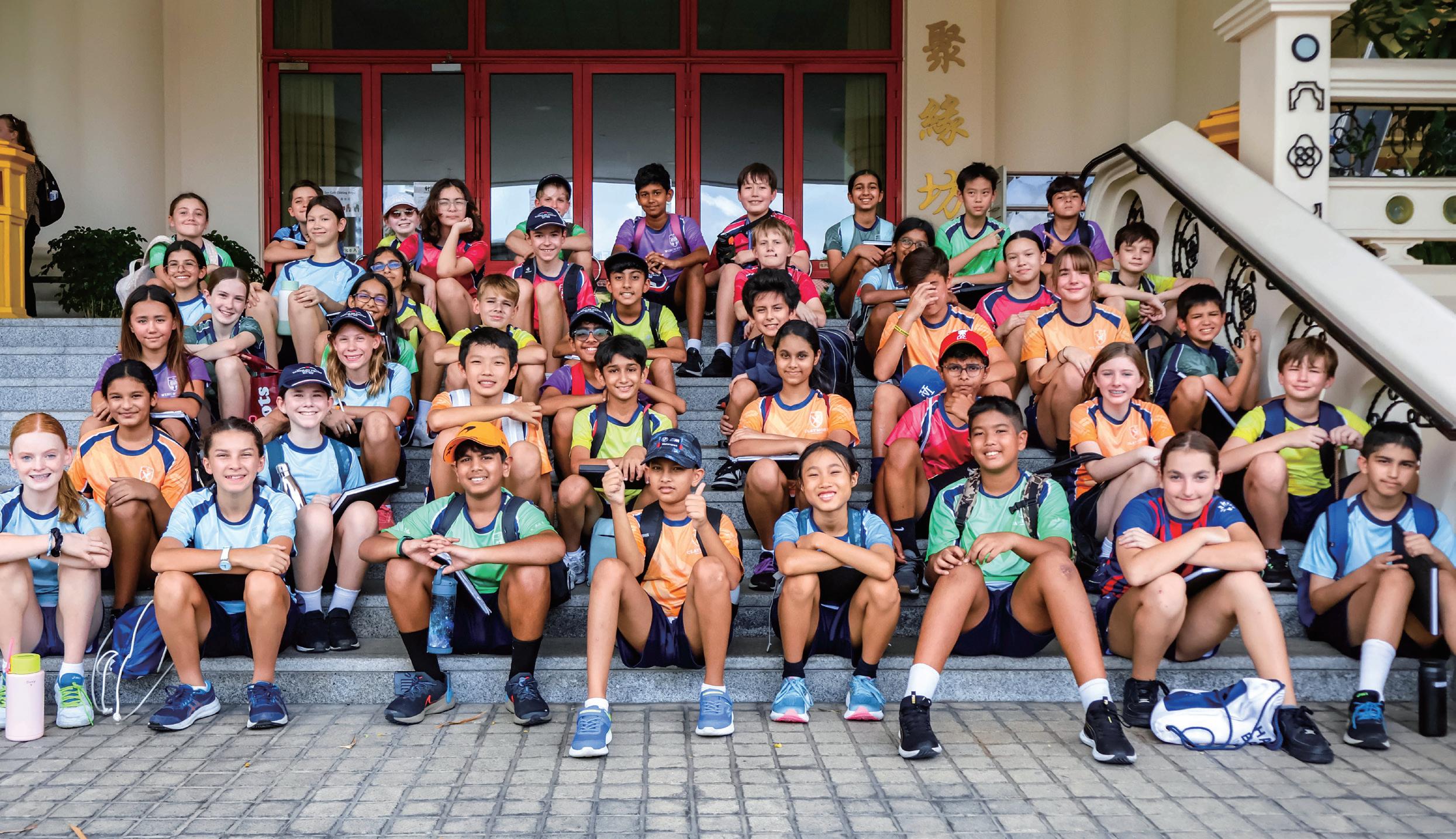

when they move back to their ‘passport’ country – much like what Hana (daughter of Tanglin’s Head of School Counselling, Claire Holmes) encountered when she left Singapore to attend university in the UK.
“I think it’s been interesting for her when she starts to talk about her life in Singapore and having a helper at home…the kind of lifestyle she leads is very different from the majority of people in the UK,” Claire explains. “Somebody said to her, ‘you live in Singapore so you’re Asian, right?’ My daughter was like ‘no, no, I’m not.’”
Being a CCK also meant that Hana and her brother Benjamin had to watch their friends leave while they become ‘stayers’. Claire acknowledges that this experience has been challenging for her children, but she also believes that it has taught them resilience. Hana, for example, maintains her strong connections to Tanglin by sharing a house with a fellow Tanglin Alumni.
While being a CCK has its challenges, it also brings about numerous wonderful experiences. “Having lived in Singapore for some time, I’ve been exposed to several communities and cultures,” Coco muses. “All of it has been incredible to learn about and immerse myself in but I have a looming fear that I could potentially distance myself from the culture I grew up in. To maintain a sense of belonging across all the groups I’m a part of, I actively utilise social media to stay updated, follow online accounts for certain groups and regularly revisiting places that were personally memorable for me.”
Year 12’s Krishiv, on the other hand, believes that his multicultural experiences play a role in shaping his character. He says, “I was born in India, the source of my roots and heritage. Then I moved to Mauritius where I developed an appreciation of nature and the French language before relocating to Dubai. There I got a glimpse of a bustling commercial hub before my family finally settled in Singapore. This has made me very passionate about learning new things.”
Georgina (2023 cohort) echoes the sentiment, expressing how being a CCK has helped hone her communication and
adaptation skills through her interactions with different people. “We are more aware of cultural diversity, and I would say, more empathetic to situational differences,” she explains.
As an international school, Tanglin is dedicated to assisting students in adjusting to the transitional lifestyle. Infant School, for example, runs “Circle Times” for new Infant children (except Nursery) at the beginning of each school term. Head of Lifeskills (Year 1/2) Leanna Dean tells us that such sessions are conducted around Week 3/4, so the children have time to settle into their new classes. During these sessions, each child gets the opportunity to meet other new children as well as discuss how they have settled in, among other things.
Claire’s counselling team meets with incoming Senior students as well. She explains, “sometimes they’d request for more time with us and other times their parents will call us beforehand to ask for extra support. We also have a lot of resources such as recordings and presentations, so we’d share these with them.”
Over at Infant and Junior School, the counselling team conducts “Leaving Well Sessions” for students who are leaving Tanglin. Infant children are gathered in a group to work on activities related to the book The Invisible String – a book about the intangible yet unbreakable connections between people. Junior students, on the other hand, work on a workbook designed to guide them through the leaving process and help them reconcile their feelings of loss and grief associated with departure. School Counsellor Pippa Gresham says, “We conduct these sessions a week or two before the student’s leaving date and we believe that they benefit the students greatly because it helps to reduce anxiety, build familiarity with other leavers, and allow them to talk openly about their hopes and fears.” ■
Want to find out more information on how to guide your cross-cultural kid? You can either check out Claire Holmes’ Arriving Well, Leaving Well and Moving On books on Amazon or keep a look out for related ParentWise sessions on the school’s weekly newsletter.

At Tanglin, theatrical productions starring students are a regular occurrence. But what happens when they take full control? Meet Rohan S, a Year 12 who spearheaded a team of 25 students to produce Frankenstein – a 45-minute adaptation of Mary Shelley’s classic.
Tell us about Frankenstein. Who are involved and what are their roles?
Frankenstein is a collaborative ensemble play that involves a team of 25 students. Within this group, the majority are actors who also take on additional responsibilities. Leading the cast are Anand and Terri from Year 12 who play Frankenstein’s Monster and Victor, respectively. To complement my role as director, a design team oversees all aspects of the production behind the scenes, from lighting and photography to promotional materials.
I had always been performing in Tanglin productions throughout my time in Senior School and I was always intrigued by what goes on backstage. Last year, I was privileged to be part of a student-directed production of Hamlet under the creative direction of Vedaant (Class of 2023). When I saw the incredible support and resources he received, I was inspired to do the same. This feels like the perfect way to broaden my horizons and take on a different role, while also giving back to the drama department that has enriched my experiences over the years.

Why an adaptation of Frankenstein?
I had first read Frankenstein as part of my Year 7 English class, and I instantly fell in love with it - what 12-yearold boy doesn’t enjoy reading about monsters! But it was after studying it in Year 11 Drama where it took on a new dimension for me. I was intrigued by how much theatrical potential it has, particularly given the world we’re in right now. The idea of a creation extending beyond our control is ever-present and feels more important than ever in this AI era. I started digging a bit further into the Nick Dear adaptation we were studying to explore the nature of the text and how it could be translated into a play. It creates many opportunities for the involvement of ensemble and a full cast – a non-negotiable for me – so it felt like the perfect fit!
How has the experience been so far? Any memorable challenges?
The overall experience has been really good and there hasn’t been a major challenge so far. The only real hurdle for me was during the scriptwriting process where I encountered inconsistencies in the way the script was written. I had been extracting parts of the novel and rewriting them where necessary and it soon became clear that some scenes sounded like they were from 1800 while others had a more contemporary feel. After getting feedback from others and carefully reviewing the script, I was able to create a more consistent tone that was more aligned with the norms of the 19th century.
Who has been most helpful in giving advice, helping out etc?
So far, there are two people whom I really couldn’t have done it without. First, Vedaant was incredibly helpful in giving me a sense of what the process would be like, having been through it himself. He has been generous with his advice that is practically useful and has helped me keep very clear and focused when working on the production. Of course, Mrs Edwards has been of enormous help as the teacher supervising this production. From speaking with the Senior Leadership team about arranging a date, to advising me on what needs to be done as well as opening up her department and their new Chandran Studio for this project. I’m incredibly grateful for all that she has done for us. ■
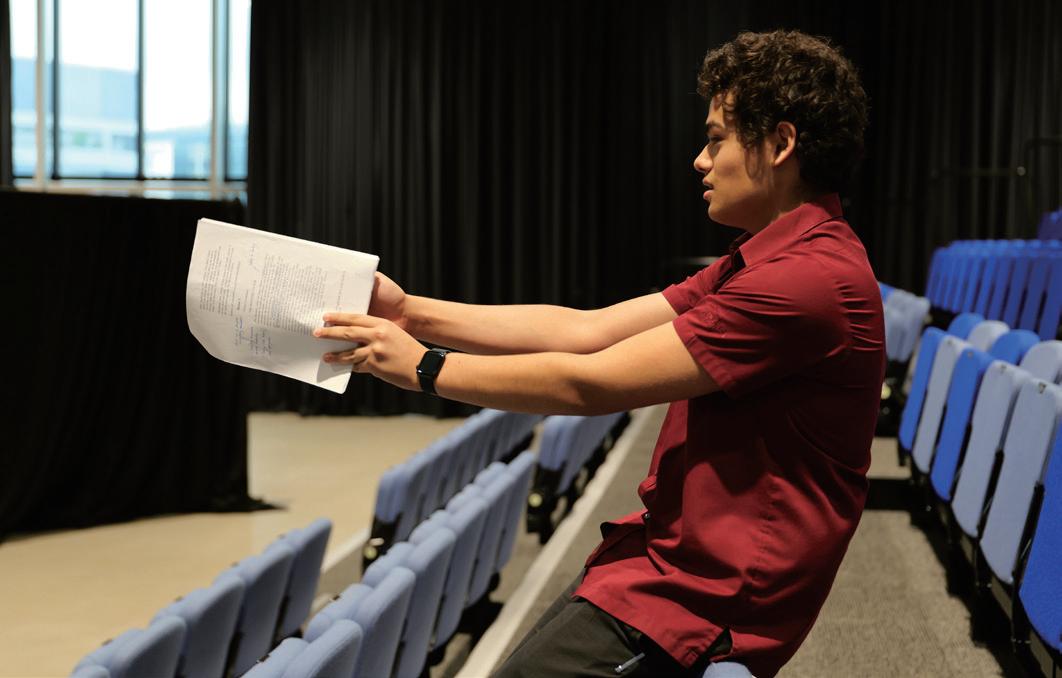



CConsent can feel like a scary topic, but it is important to start early. Clare Lancaster, Educational Psychologist & Whole School Safeguarding Lead, explains why.
onsent can feel like a scary topic, but it is important to start early. In Tanglin, we teach about consent through everyday interactions, modelling the skills of asking for consent, and through explicit lessons about consent, respect, and boundaries, including age-appropriate personal safety and how to keep others safe. Some of our Sixth Formers told us they wished their parents had been given guidance on how talk to them about consent.
We want our children to have a clear understanding of what constitutes consent and what does not, and to be able to give or withhold consent in a variety of situations. They need to observe and practise the skills of confidently asserting their boundaries and accepting others’ responses from an early age.
Here are some ideas to start the conversation early:
Don’t force hugs and kisses: Children who are forced to hug or kiss others even when they are uncomfortable may learn to suppress their own feelings of discomfort to make others happy. This can make it hard to assert their boundaries later
and they may struggle to say “no”. If your child is uncomfortable with physical contact, don’t force them. We can still teach the importance of manners and how to greet people without forcing physical contact. Give alternatives, and if necessary, hold the boundary for them – “He’s not in the mood for a hug today, go for a high five or wave instead.”
Stop when they say “stop”: When tickling or roughhousing, teach and show (by doing it every time) that if anyone says “no” or “stop”, then the game stops immediately. This can be a fun part of the game and as simple as “stop – everyone, hands up”. It’s not necessarily the end of the game – it can resume if your child gives the go ahead. Teaching your child their “stop” is respected is important in empowering them to feel able to say “stop” in later life and shows it’s alright to withdraw consent if they are not enjoying something.
Give them scripts: This helps empower a child to express themselves if they don’t like something or feel uncomfortable. You just have to tell your child exactly what they can say - “You can say “Stop it” if you don’t like it anymore” / “It’s ok for you to say, “No thanks””.

The Alumni Grant is available to all Year 13 Students and Alumni (undergraduates aged 18 to 23 and up to 6 months after graduating from university).
Funded by the philanthropic works of the Tanglin Trust School Foundation, Alumni are encouraged to undertake projects in their communities and elsewhere with the opportunity to learn, give back and in the process act as positive role models for our current students. Activities and projects that relate to CAS (Creativity, Action and Service) form the basis for the applications. This is matching grant (against your own earnings).
If you are looking at a gap year project, then do consider applying. Alumni may apply as individuals or as a group (max 4 in a group of fellow alumni).
To apply or for more details, submit the application form on alumni.tts.edu.sg or email us at alumni@tts.edu.sg.



Here are some ways to keep the conversation going as your child grows:
Help your child respect consent: Point out moments in daily life and talk about other people’s responses to help reinforce that “no” is ok to foster respect for other people’s boundaries, and an expectation of respect for their own - “Lee doesn’t want to play anymore; find something else to do.” / “Remember to ask before you hug someone.” / “Did you ask if you could post that photo of them?”
Check in on consent: Help your child understand that consent one time does not mean consent every time, and consent may be situation or person dependent. Checking for ongoing consent is important and can be as simple as, “Can I snuggle next to you again?” / “Is it ok if Charlie has another go on your iPad?” / “You’ve had Brooklyn’s Kindle for ages, check they’re still ok with you reading it.”
Model social media consent: We tell children not to post about others without permission, or share anything they don’t want on the internet forever, but do we follow our own advice? Keep your page and photos of your child private until they’re old enough to consent to their image being shared and model behaviour you want to see - “I want to post this selfie, is that ok?” / “Are you happy with this TikTok before I hit post?”
“
We can still teach the importance of manners and how to greet people without forcing physical contact. ”
Have open and honest communication: Use proper labels for body parts so your child can confidently communicate without shame or discomfort. If something related to consent comes up in a TV show or movie, ask what your child thinks of it, and use that as a way into a conversation. If your child asks a surprising or tricky question, you can always tell them you are not sure or need to have a think about it and then revisit the conversation later.
Consent is a broad subject; by being clear on it when it applies in daily life, we can take some of the fear and confusion out it and empower our children to be safe and respectful as they grow. ■
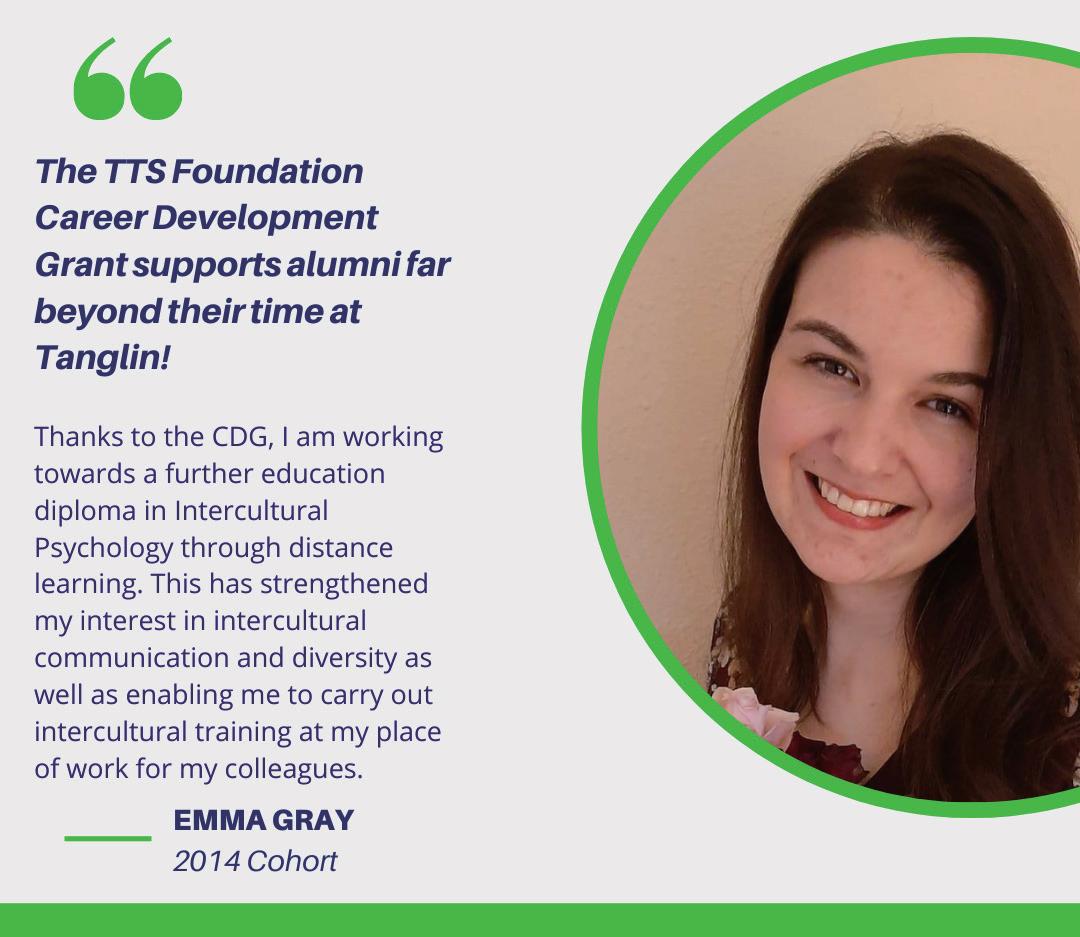
The purpose of the Career Development Grant is to support Tanglin Alumni who are embarking on career progression programmes or education that will offer them advancement and growth in their chosen profession.
Made possible by the Tanglin Trust School Foundation, Alumni between the ages of 24 and 35 years are eligible to apply.
All applications must be accompanied by a written proposal and successful applicants will be invited to attend a panel interview that includes the CEO of Tanglin Trust School, amongst the panelists.
Previous recipients have embarked on programmes in the field of marketing, education, business and sports.
NEXT APPLICATION:
DEADLINE: 1 May 2024
To apply or for more details, email us at alumni@tts.edu.sg.

